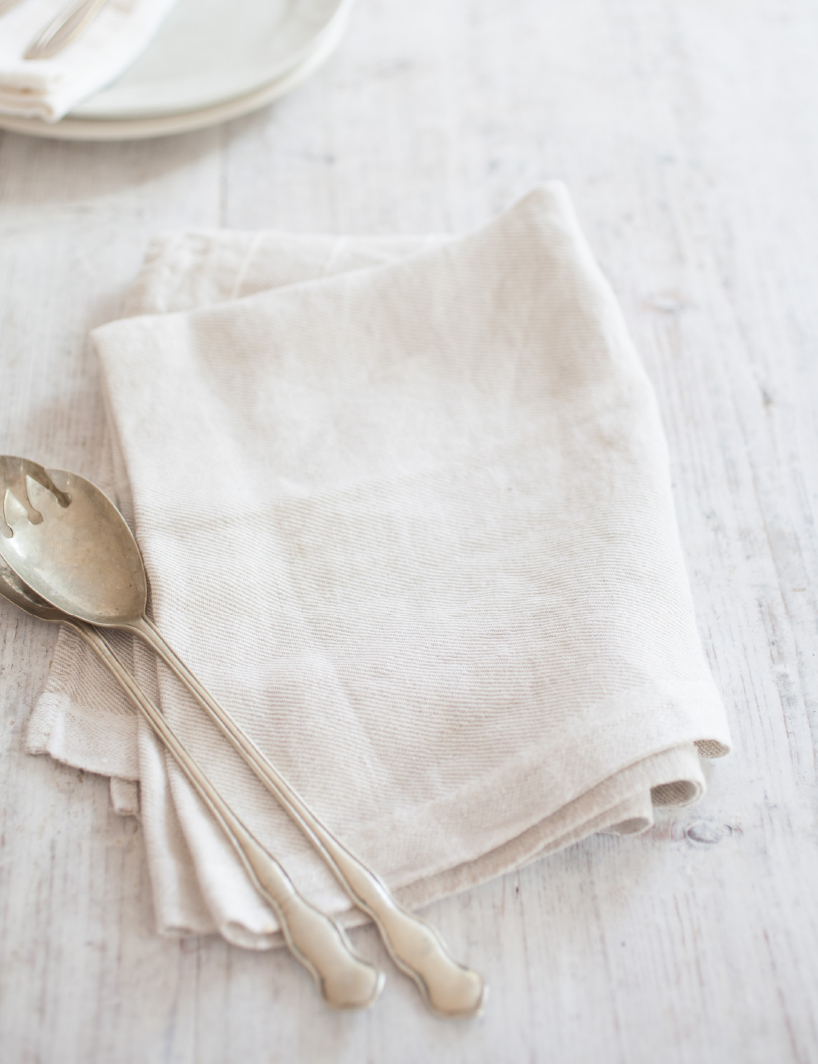Slow Dough: Real Bread: Bakers' secrets for making amazing long-rise loaves at home - Chris Young (2016)
Sourdough
The oldest (and some people would say still the best) way of leavening a loaf is by using a sourdough starter.
Yeasts and bacteria are found in the air, soil, water … basically everywhere. It might or might not be a coincidence that the surfaces of cereal grains tend to teem with types that are suited to bread making. After grinding the grains, some of these critters remain in the flour and by creating the right conditions you can nurture them into a thriving culture.
Eventually there will be enough yeast cells in the culture giving off carbon dioxide to make dough rise. At the same time, lactic acid bacteria will be producing lactic and acetic acids.
This all happens relatively slowly and over this longer fermentation time, acids, enzymes and by-products the microbes generate have beneficial effects on the flavour, texture and aroma of the finished bread. The processes can also have a natural preservative effect and might have health benefits, too.
Spelt Sourdough ANDREW AULD
Whatever anyone tells you, spelt is a type of wheat, though some people who struggle with eating bread wheat find that they are fine with spelt. Whether this is because of differences in the grains or the processes by which each is typically made into loaves is not yet determined. For the purposes of this book, all you really need to know is that spelt makes a relatively high-protein flour with plenty of nutty flavour, especially if you choose wholemeal/wholegrain.
MAKES: 2 small loaves
FROM MIXING TO OVEN: 16-18 hours, or overnight plus 4 hours
BAKING TIME: 40 minutes
FOR THE PRE-FERMENT:
60g/2¼oz/½ cup light spelt flour
60g/2¼oz/½ cup wholemeal/ wholegrain spelt flour
50g/1¾oz/3½ tbsp water
15g/½oz/1 tbsp rye sourdough starter
FOR THE DOUGH:
250g/9oz/2 cups light spelt flour
250g/9oz/2 cups wholemeal/wholegrain spelt flour
300g/10½oz/1¼ cups water
50g/1¾oz/3½ tbsp orange juice
10g/2 tsp honey
7g/1½ tsp fine/table salt
1. Mix the pre-ferment ingredients together thoroughly, cover and leave at room temperature for 12-14 hours (typically overnight).
2. Mix the pre-ferment with the dough ingredients, then knead everything together until you have a smooth and stretchy dough. Cover and leave for 3 hours, giving the dough a single fold after 1 and 2 hours.
3. Divide the dough into 2 equal-size pieces and shape as desired. If using proving baskets, dust them well with flour and place the dough in them, seam-side up, though for flatter loaves you can simply leave the shaped dough on a floured work surface, seam-side down. Cover the dough and leave to prove for 1 hour.
4. Heat the oven to 240°C/220°C fan/475°F/gas 8-9, with a large baking stone or baking sheet in place.
5. Either turn the loaves out of their baskets, or carefully transfer them from the work surface, so they are seam-side down on a floured peel. Slide the loaves onto the baking stone and bake for 10 minutes, then turn the oven down to 200°C/180°C fan/400°F/gas 6 and continue to bake for a further 30 minutes. Remove from the oven and leave on a wire rack to cool.
Andrew Auld opened “the loaf” in 2008, reinvigorating a bakery that had been in the Derbyshire village of Crich since 1919. As well as offering Real Bread and other baked goodies, it acts as a community hub. The bakehouse is a place to meet, eat and socialize, while the bakers work with groups including the village primary school.

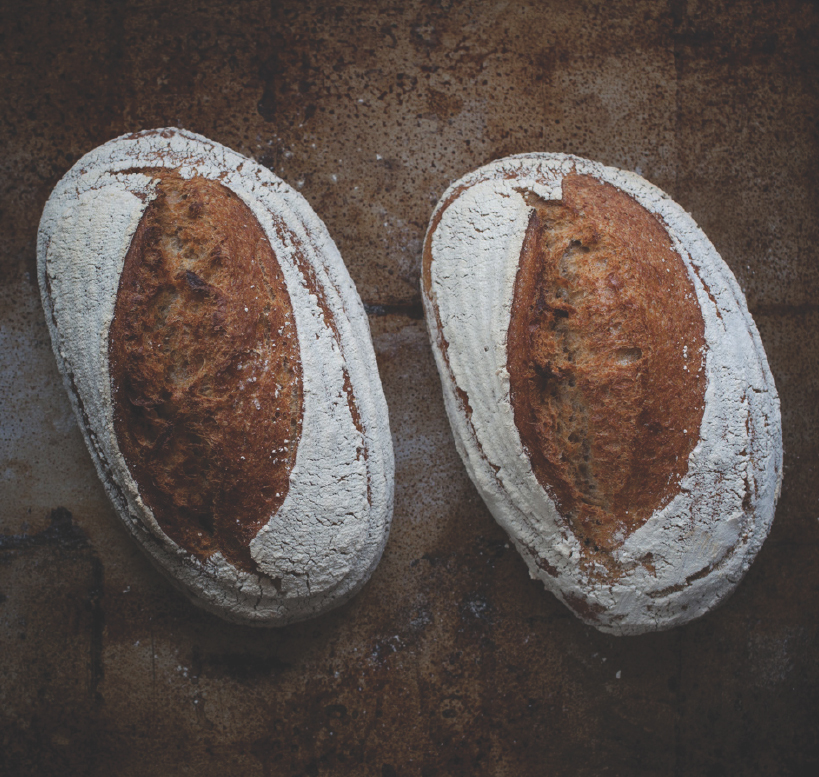
Michael Fahy and his wife Helen started The Island Bakers on the Isle of Wight in 2010 after Michael fell in love with making sourdough bread. Originally chefs, Michael and Helen found that they were not alone in wanting a supplier of Real Bread to complement the food they were serving. He says that this pumpkin bread is their most popular loaf throughout the autumn.

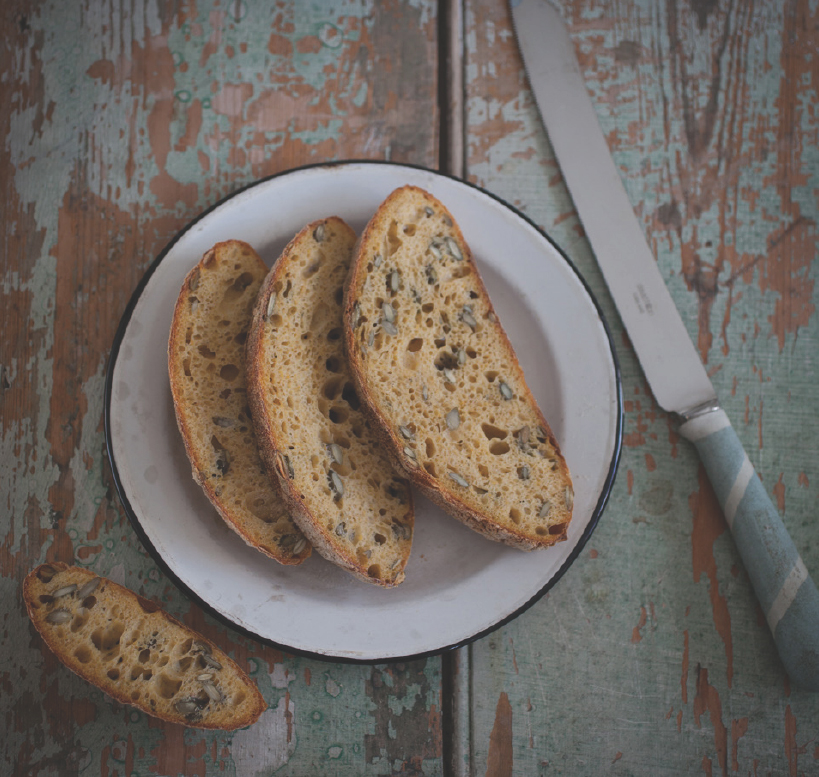
Roasted Pumpkin Sourdough MICHAEL FAHY
The pumpkin or squash needs to be a firm-fleshed variety, rather than one of the big, woolly types best suited to Hallowe’en lanterns. Michael suggests Crown Prince winter squash, “because of the nutty flavour and robust flesh”. Adding some pumpkin seeds gives extra texture, for the perfect loaf.
MAKES: 2 large loaves
FROM MIXING TO OVEN: 2 days plus 2 hours
BAKING TIME: 45-50 minutes
FOR THE PRE-FERMENT AND PUMPKIN:
5g/1 tsp white sourdough starter
100g/3½oz/¾ cup minus ½ tbsp white bread flour
15g/1¾ tbsp wholemeal/wholewheat bread flour
115g/4oz/½ cup water, at room temperature
1 small pumpkin or squash
vegetable oil, for brushing and greasing
salt flakes
thyme sprigs
FOR THE DOUGH:
310g/11oz/1¼ cups plus 1 tbsp water, at room temperature
450g/1lb/about 3¼ cups white bread flour
30g/1oz/scant 3½ tbsp wholemeal/ wholewheat bread flour
12g/2 tsp fine/table salt
100g/3½oz/¾ cup shelled pumpkin seeds, lightly toasted
1. Mix the starter, both flours and the water for the pre-ferment together thoroughly, cover and leave at room temperature for 16-18 hours (typically overnight).
2. Heat the oven to 180°C/160°C fan/350°F/gas 4. Cut the pumpkin in half, scoop out the seeds and rub the flesh with oil and salt. Place the thyme stalks into the cavities of the pumpkin, put them cut-side down onto a greased baking sheet and roast for 1-2 hours, or until the pumpkin flesh is soft and has some caramelization. Leave to cool completely, then scoop the pumpkin flesh out in large chunks, reserving 200g/7oz of it for this recipe and discarding the skin (any spare pumpkin can be frozen for another time, or used in another recipe).
3. Next day, thoroughly mix the pre-ferment with the water and both flours for the dough. Cover and leave to rest for 30-60 minutes. Add the salt and knead for 2-4 minutes, then add the pumpkin flesh and seeds, scrunching them into the dough with wetted hands. Cover and leave to prove for 1 hour.
4. Turn the dough out onto the work surface and give it a single fold, return it to the bowl, cover and prove for a further 1 hour, or until the dough is light, bubbling and doubled in size.
5. Turn the dough onto the work surface, divide it into 2 equal-size pieces and shape into balls. Flour 2 proving baskets and place the dough in them, seam-side up. Cover and leave to prove in the refrigerator overnight, taking them out 1-2 hours before baking.
6. Heat the oven to 250°C/230°C fan/480°F/gas 9+, or as high as it will go, with a baking stone or baking sheet in place. Turn the loaves out onto a floured peel one at a time, then slide them onto the baking stone. Bake for 15 minutes, then turn the oven down to 200°C/180°C fan/400°F/gas 6, and continue to bake for another 30-35 minutes.
Fig and Fennel Sourdough ROGER BIRT
Roger chose to share this recipe as he feels “it epitomizes our ethos of producing great-tasting breads that encourage customers to try something different”.
MAKES: 1 large loaf
FROM MIXING TO OVEN: overnight plus 5 hours
BAKING TIME: 30 minutes
FOR THE PRE-FERMENT:
100g/3½oz/scant ½ cup white sourdough starter
75g/2½oz/½ cup plus ½ tbsp white bread flour
75g/2½oz/scant ⅓ cup water
FOR THE DOUGH:
350g/12oz/2½ cups white bread flour
150g/5½oz/1 cup wholemeal/ wholewheat bread flour
300g/10½oz/1¼ cups water
10g/1 heaping tbsp green fennel seeds
10g/2 tsp fine/table salt
175g/6¼oz/scant 1¼ cups quartered dried figs
1. Mix the pre-ferment ingredients together thoroughly, cover and leave at room temperature for 12-14 hours (typically overnight).
2. To make the dough, add both flours with the water and fennel seeds to the pre-ferment, and mix thoroughly. Cover and leave to rest at room temperature for 20-30 minutes.
3. Mix in the salt and knead for a few minutes. Cover and leave to rest at room temperature for another 30 minutes.
4. Turn the dough out onto a lightly floured work surface, using a rolling pin to roll it out into a rectangle. Distribute the figs evenly over half the dough, then fold the other half over them, pressing the edges together to seal. Roll the dough out again, fold in half and roll out once more. If the figs are not evenly distributed, repeat the process but be careful not to mush them up completely.
5. Shape the dough into a ball, cover and leave to prove at room temperature for 1 hour.
6. Give the dough a single fold, cover and leave to prove for another 2 hours, or until almost doubled in size.
7. Dust a proving basket well with flour. Turn the dough out onto a lightly floured work surface and shape to fit the basket. Place the dough seam-side up in the basket, cover and leave to prove at room temperature for 1 hour.
8. Heat the oven to 230°C/210°C fan/450°F/gas 8, with a baking stone or baking sheet in place. Turn the dough out onto a peel and slide it onto the baking stone. Bake for 10 minutes, then turn the oven down to 200°C/180°C fan/400°F/gas 6 and bake for a further 20 minutes, checking halfway through that it is not browning too quickly.
Roger Birt and his wife Sally set up Red Dog Bakery in North Devon after successful non-food careers. They began to head down this path when the stomach cramps Roger experienced eating industrial loaves were non-existent when enjoying Real Bread. Roger began baking at home, went on courses and, inspired by David and Holly Jones at Manna from Devon, turned it into a business.

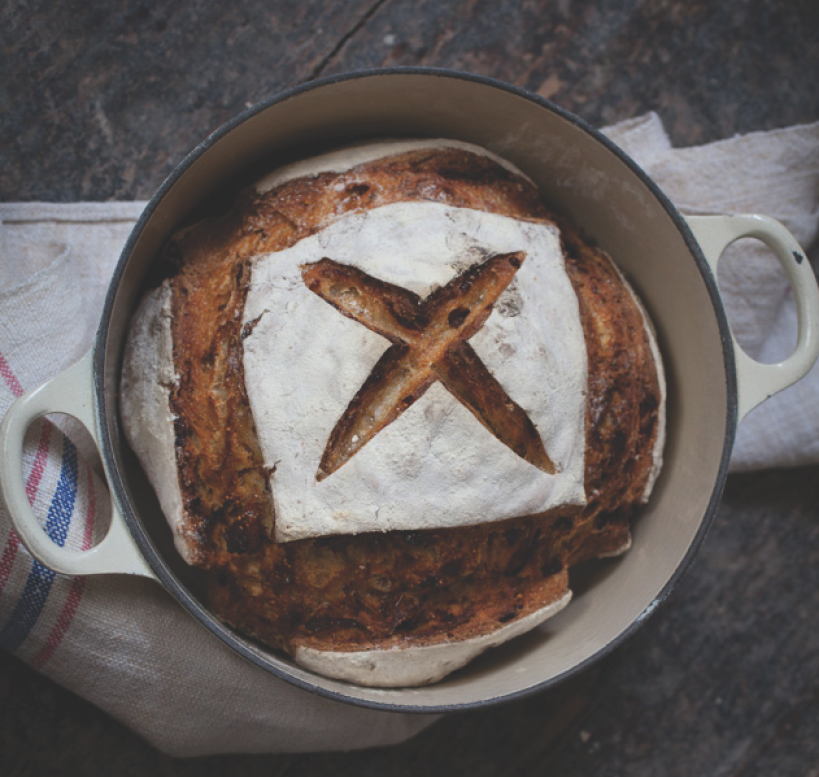
Seeded Wholemeal Sourdough CRAIG SAMS
This loaf’s roots reach back to Ceres, the organic bakery that Craig and his brother Greg Sams owned on Portobello Road in London’s Notting Hill. In turn, Ceres was inspired by thedesem baking of Omer Gevaert at the Lima bakery he founded in Ghent, Belgium, in 1963. The loaf continued to evolve when Craig and his wife Jo took over Judges Bakery in Hastings on England’s south coast, with the addition of kelp granules and hemp, sesame and linseeds/flaxseeds.
MAKES: 1 large loaf
FROM MIXING TO OVEN: 4-7 hours
BAKING TIME: 30-40 minutes
400g/14oz/scant 3 cups wholemeal/ wholewheat bread flour
100g/3½oz/scant ½ cup wholemeal/ wholewheat sourdough starter
25g/1oz/heaping 2¾ tbsp sesame seeds
7g/1 tbsp hemp seeds, hulled
35g/1¼oz/¼ cup linseeds/flaxseeds
2g/½ tsp kelp granules or powder
8g/1½ tsp fine/table salt
300-330g/10½-11¾oz/1¼-1⅓ cups water
rolled oats, for topping
1. Mix all of the ingredients except the oats together thoroughly. Cover the dough and leave to rest for 10 minutes.
2. Knead the dough until smooth and stretchy, cover and leave to prove at room temperature for 1 hour.
3. Shape the dough to fit a large proving basket, lightly dampen the top of the dough with a little water, and roll it in the oats.
4. Dust the large proving basket well with flour and place the dough in it, seam-side up. Cover and leave to prove at room temperature for 3-6 hours or until doubled in size.
5. Heat the oven to 200°C/180°C fan/400°F/gas 6, with a baking stone or baking sheet in place. Turn the dough out onto a floured peel, seam-side down, slash the top, then slide it onto the baking stone and bake for 30-40 minutes.
Craig Sams has been a food pioneer in Britain since arriving from the USA in 1966. In 1968, he and brother Greg established macrobiotic restaurant Seed. This was followed by Ceres Grain Shop, Harmony Foods (later to become Whole Earth Foods), and in 1972, Ceres Bakery. With his wife Jo Fairley, Craig founded Green & Black’s chocolate, producer of the UK’s first Fairtrade certified product, and later moved to Judges Bakery in Hastings. He is chairman of Carbon Gold, a leading biochar company and Gusto Organic, producers of organic Fairtrade low-calorie cola.
Rye Sourdough ALEX GOOCH
By adding a slight bitter-sweetness with black treacle/molasses, Alex’s variation on a basic rye sourdough gives your tastebuds a very pleasurable workout. This loaf goes very well with hard and blue artisan cheeses.
MAKES: 2 small loaves
FROM MIXING TO OVEN: 4½-5 hours
BAKING TIME: 45 minutes
400g/14oz/scant 3⅔ cups light rye flour, plus extra for dusting
300g/10½oz/3¼ cups rye sourdough starter
330g/11¾oz/1⅓ cups water
50g/1¾oz/⅓ cup chopped rye grains
15g/1 tbsp black treacle/molasses
10g/2 tsp fine/table salt
butter, for greasing
1. Mix all of the dough ingredients together in a bowl to form a thick batter, cover and leave to rest for 30 minutes. Meanwhile, grease two 500g/1lb loaf tins.
2. Divide the batter evenly between the two loaf tins and lightly dust the top of each with rye flour. Cover and leave at room temperature for about 4 hours until risen to the top of the tins.
3. Heat the oven to 200°C/180°C fan/400°F/gas 6. Uncover the tins, dust the loaves with rye flour again and bake for 45 minutes.
4. Remove the loaves from the oven and turn out onto a wire cooling rack to cool. As rye loaves of this type are very sticky inside when just baked, the fully cooled loaves then need to be left in a bread bin or other suitable container for at least 4 hours and preferably a day or two before eating (if you can wait that long).
Alex Gooch started his organic Real Bread bakery in 2007 with loans from family and friends. At first he worked hundred-hour weeks to establish the business, selling at festivals and food markets. In 2010 he was named Best Food Producer at the BBC Food & Farming Awards. Alex says “I’ve always been fascinated by bread. My absolute love and passion for it drove me on. Top-quality organic ingredients are essential. I work with many grains, including stoneground British heritage varieties.”

Baker’s Tip: For variety, you can add a small handful of seeds, chopped nuts or raisins or other dried fruit into the mixture.
Fergus Jackson and his wife Sharmin set up Brick House bakery in southeast London in April 2012 having grown tired of corporate life. His loaf learning includes stints at San Francisco Baking Institute, Tartine in the same city and E5 Bakehouse in London. Specializing in San Fran-style sourdoughs, his accolades include being noted as one of London’s top 5 bakeries by The Financial Times Weekend Magazine.
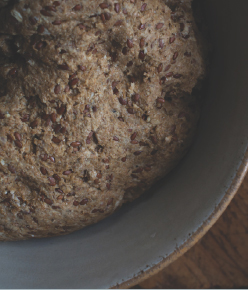
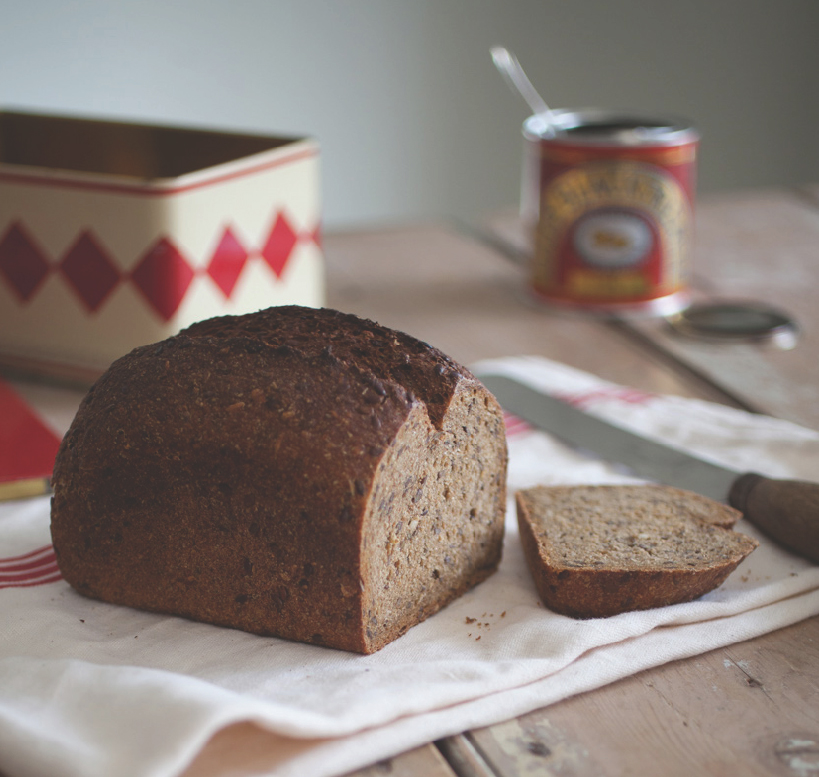
The Shackleton FERGUS JACKSON
The polar explorer Sir Ernest Shackleton went to school in Dulwich, in the same part of London where Fergus now bakes. This recipe includes black treacle/molasses as a nod to the tins of golden syrup taken by the explorer on his expeditions, and Fergus says, “I like to think of this as the loaf he slipped into his backpack before heading off to the South Pole.” It goes well with smoked fish, Marmite, goats’ (chevre) or blue cheese, radishes and salt, or just butter.
MAKES: 1 large loaf
FROM MIXING TO OVEN: 6-7 hours
BAKING TIME: 50-60 minutes
FOR THE SOAKER:
75g/2½oz/heaping ¾ cup jumbo rolled oats
75g/2½oz/½ cup linseeds/flaxseeds
150g/5½oz/scant ⅔ cup water
FOR THE DOUGH:
170g/6oz/scant 1¼ cups wholemeal/ wholewheat bread flour
170g/6oz/1½ cups wholemeal/ wholegrain (dark) rye flour
85g/3oz/½ cup plus 1 tbsp white bread flour
205g/7¼oz/¾ cup plus 2 tbsp water
100g/3½oz/scant ½ cup wholemeal/ wholewheat or rye sourdough starter
45g/1½oz/generous 2 tbsp black treacle/molasses
10g/2 tsp fine/table salt
oil, for greasing
1. Mix the soaker ingredients together and leave for at least 2 hours.
2. Mix all of the ingredients including the soaker together until thoroughly combined, to make a sticky, shaggy dough. Transfer this to a lightly oiled bowl, cover and leave to prove at room temperature for 45 minutes.
3. Give the dough a single fold, cover and leave to prove for a further 45 minutes.
4. Turn the dough out onto a lightly floured work surface, flatten it out and then shape it into a ball. Cover and allow to rest for 20 minutes.
5. Grease a 1kg/2lb loaf tin, shape the dough to fit and place it in the tin, seam-side down. Using a wet hand, press the dough down gently to fill out the tin into the corners and flatten the loaf’s shape. Cover and leave to prove at room temperature for 2-3 hours. This is a fairly dense loaf so the dough will not rise dramatically during the final proving but you should see an increase in size and a gentle doming of the surface.
6. Heat the oven to 230°C/210°C fan/450°F/gas 8. Slash a line down the middle of the dough, place in the oven and bake for 50-60 minutes. Remove from the tin as soon as possible and leave to cool completely, ideally for 12 hours or more, before cutting.
Beetroot Sourdough LAURA BULLOCK
Laura says that this loaf has “earthy flavours that are perfect with goats’ cheese and mackerel”. The beetroot/beet lends the white crumb an unusual burgundy colour; a simple variation would be to replace the beetroot/beet with grated carrot or parsnip, which will give an orange or creamy fleck to the crumb, depending on the vegetable used.
MAKES: 2 small loaves
FROM MIXING TO OVEN: 2½-3 hours then overnight
BAKING TIME: 20-25 minutes each loaf
430g/15¼oz/3 cups white bread flour
100g/3½oz/scant ½ cup white sourdough starter
8g/1½ tsp fine/table salt
250g/9oz/1 cup plus 1 tbsp water
330g/11½oz/scant 2¼ cups peeled raw grated beetroot/beets
1. Mix the flour, sourdough starter, salt and most of the water together thoroughly. If the dough is too stiff, add more of the water. Knead the dough until smooth and stretchy, then cover and leave to rest for 10 minutes.
2. Flatten the dough out to form a rectangle. Scatter the beetroot/ beets over it and knead in until distributed evenly. The dough will be very soft and sticky. Shape into a ball, cover and leave to rest for 30 minutes.
3. Give the dough a single fold and rest for a further 30 minutes, then fold and rest for 30 minutes twice more.
4. Dust two 500g/1lb proving baskets with flour. Divide the dough into 2 equal-size pieces and shape to fit the baskets. Place the dough in the baskets seam-side up, cover and leave to prove in the refrigerator for 12 hours overnight.
5. Heat the oven to 250°C/230°C fan/480°F/gas 9+, or as high as your oven will go, with a baking stone or baking sheet in place. Turn one piece of dough out of its basket onto a floured peel and slash the top, then slide it onto the stone. Bake for 20 minutes, or 25 if you prefer a slightly darker crust. Repeat with the remaining piece of dough.
Laura Bullock and Matina Mitchell met at the School of Artisan Food, where they decided to set up their own bakery. Experience at a market in Sheffield during their course convinced them that there was the demand for a Real Bread bakery in the city. They launched Seven Hills Bakery in November 2011, and the team quickly grew from three to ten people in its first 18 months.
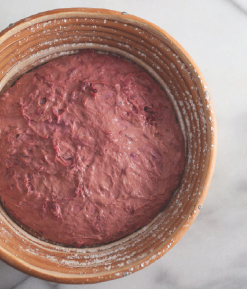
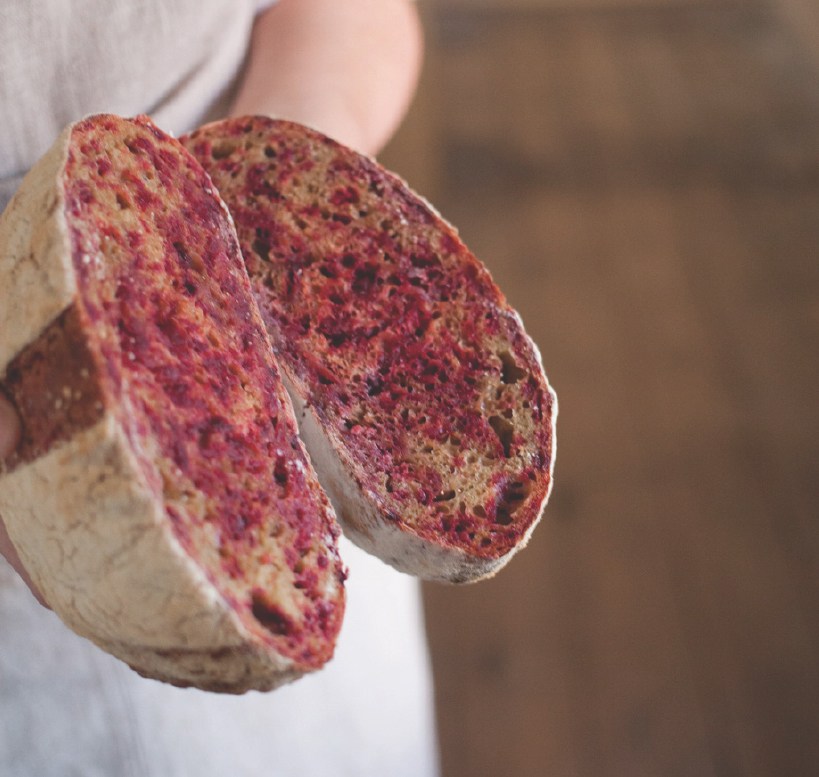
Victoria Osborne has been baking for about 20 years. She told me that she thinks her microbakery, Wraxall Real Bread, might be the smallest in Wiltshire. She bakes sourdoughs and other slowly proved breads, which include combinations like nettle and wild garlic, once a week to sell at a local country market.

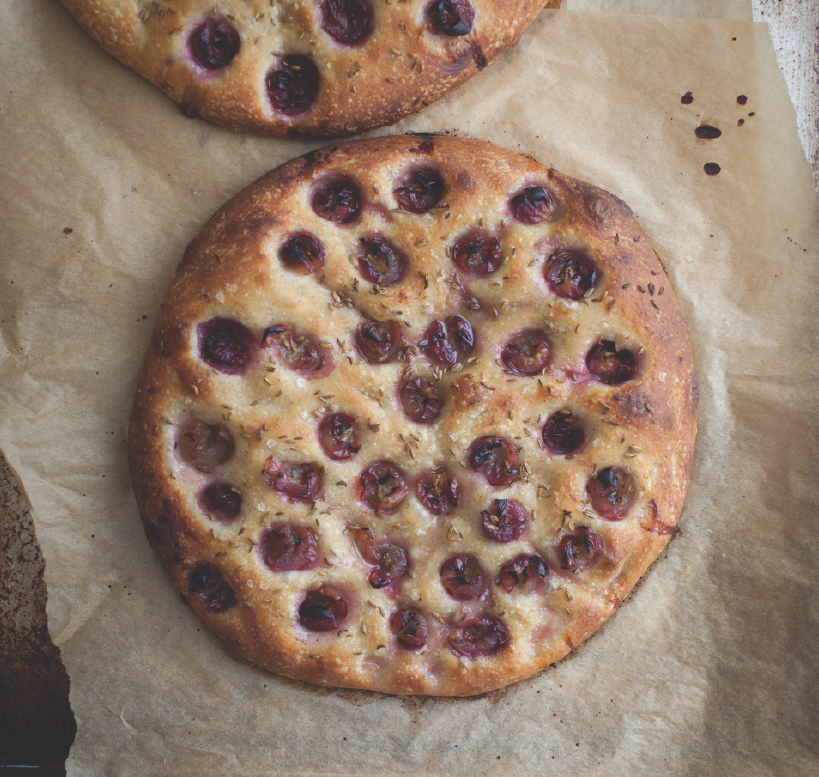
Red Grape and Fennel Seed Schiacciata VICTORIA OSBORNE
This is Victoria’s sourdough version of schiacciata con l’uva, a Tuscan member of the hearth-bread family that also includes focaccia and fougasse. Recipes often include rosemary, rather than fennel seeds, and may be topped with sugar instead of salt.
MAKES: 2 small loaves
FROM MIXING TO OVEN: overnight plus 3½-4 hours
BAKING TIME: 15-20 minutes
500g/1lb 2oz/3½ cups white bread flour
20g/2 tbsp semolina
100g/3½oz/scant ½ cup rye sourdough starter
5g/1 tsp fine/table salt
300g/10½oz/1¼ cups tepid water
60g/2¼oz/generous ⅓ cup olive oil, plus 2 tbsp for drizzling
250g/9oz/2-2½ cups seedless red grapes
fennel seeds, for sprinkling
coarse sea salt flakes, for sprinkling
1. Mix the flour, semolina, starter, salt and water together thoroughly, until all of the ingredients have come together in a sticky mass with no dry bits remaining. Add the olive oil and work it gently into the dough. Place in a lightly oiled bowl, cover and leave to rest for 30 minutes.
2. Give the dough a single fold, cover and leave to rest for another 30 minutes.
3. Repeat this fold and rest process three more times, after which the dough should be very smooth and stretchy. Cover the dough again and leave in the refrigerator overnight.
4. Take the dough out of the refrigerator and leave for at least 1 hour to come up to room temperature. Turn the dough onto a lightly oiled work surface and divide it into 2 equal-size pieces. Gently shape each piece into a ball, cover and leave it to relax for 30 minutes.
5. Lightly flatten each piece of dough with the heel of your hand to form a circle, then place onto baking sheets lined with non-stick baking parchment. Cover and leave to prove for 2 hours.
6. Drizzle 1 tablespoon of oil over each piece of dough and lightly spread it across the surface. Squeeze the grapes gently until they break (schiacciata means “crushed”) and press them deep into the dough. Sprinkle the tops with fennel seeds and salt to taste, then cover and leave to prove again while the oven heats up.
7. Heat the oven to 240°C/220°C fan/475°F/gas 8-9. Bake the loaves for 15-20 minutes, or until risen and pale golden.
Pane di Patate PAOLO MAGAZZINI
Paolo is a professional baker in Garfagnana, in the province of Lucca, Italy. Made there, using particular flour, potatoes, methods and a wood-fired oven, this loaf is allowed to bear the name Pane di Patate della Garfagnana and is supported by a Slow Food Presidium. The tipo 1 flour used in this recipe is a creamy-to-beige-coloured farina di grano tenero, milled from “common” wheat rather than the grano duro (durum wheat) used more often for pasta.
MAKES: 1 large loaf
FROM MIXING TO OVEN: 4-8 hours
BAKING TIME: 1 hour
100g/3½oz/scant ½ cup mashed potato, a floury/starchy variety
310g/11oz/3 cups tipo 1 flour
310g/11oz/2½ cups wholemeal/ wholegrain emmer flour (Italian farro, Triticum dicoccum)
10g/2 tsp fine/table salt
100g/3½oz/scant ½ cup white sourdough starter
370g/13oz/1½ cups plus 1 tbsp cooking water, reserved from boiling the potatoes (at 38-40°C/ 100-105°F)
fine polenta flour/cornmeal, for dusting
1. Peel, boil, drain and mash the potato, reserving the cooking water. Measure out the amount of mashed potato required for the recipe, setting any leftovers aside for another purpose. Mix the potato and all of the other dough ingredients together thoroughly, then knead the dough until it is smooth and stretchy. Cover and leave to rest for 10 minutes.
2. Dust a large proving basket with fine polenta flour/cornmeal. Shape the dough into a ball, roll the seam-side in fine polenta flour/cornmeal and place seam-side up in the basket. Cover and leave to prove at room temperature for 4-8 hours.
3. Heat the oven to 250°C/230°C fan/480°F/gas 9+, or as high as it will go, with a baking stone or baking sheet in place. Turn the dough out, seam-side down, onto a polenta/cornmeal-dusted peel and slide onto the baking stone. Bake for 15 minutes, then turn the heat down to 200°C/180°C fan/400°F/gas 6 and continue to bake for another 45 minutes.

Baker’s Tip: Despite what the literal translations of the Italian names might suggest, the flour you are using here is bread making flour, not a “soft” plain/all purpose flour.
Paolo Magazzini is a farro and beef farmer and the baker in Petrognola, Tuscany. His mother was the village baker until she died in 2000. Seeing his mother’s sadness that her bread wouldn’t live on, Paolo promised he would continue to bake it. As well as her recipes, he still uses her madre (sourdough starter) that has been kept alive for more than 50 years.
Elderflower Sourdough JOE FITZMAURICE
Elder (Sambucus nigra) grows across Europe like a weed. When foraging for elderflowers, avoid any near roads or that may have been sprayed with herbicides or pesticides. To prepare them, brush and shake off any dirt and insects, and discard all but the smallest part of the stalk. Don’t wash the flowers as they will lose much of their scent and flavour. Make sure that you are gathering Sambucus nigra, as other members of the genus are considered to be toxic.
MAKES: 2 large loaves
FROM MIXING TO OVEN: 5 hours
BAKING TIME: 30-35 minutes
710g/1lb 9oz/5 cups white bread flour
210g/7½oz/scant 1 cup white sourdough starter
490g/1lb 1¼oz/2 cups water
15g/3 tsp fine/table salt
35g/1¼oz elderflowers, cleaned
1. Mix the flour, the starter and all but 20g/4 tsp of the water together thoroughly, then knead the dough for a few minutes. Cover and leave to rest for about 20 minutes.
2. Stretch the dough out on the work surface, sprinkle with the salt and remaining water and knead until you have a smooth and stretchy dough.
3. Gently knead the elderflowers into the dough until they are evenly distributed, then divide the dough into 2 equal-size pieces, shape into balls, cover and leave to rest at room temperature for about 10 minutes.
4. Dust two large proving baskets generously with flour. Shape the dough balls to fit the baskets and place them in, seam-side up. Cover and leave to prove at room temperature for about 4 hours. To get large, uneven holes in the crumb and good oven spring, Joe suggests that the dough should be placed in the oven slightly under-proved.
5. Heat the oven to 220°C/200°C fan/425°F/gas 7, with a baking stone or baking sheet in place. Turn 1 loaf out onto a floured peel, slash the top and slide it onto the baking stone, then repeat with the second loaf. Bake for 20 minutes, check on how the loaves are progressing, then continue to bake for another 10-15 minutes until done.
Joe Fitzmaurice began baking professionally at his sisters’ Dublin deli in 2000, before they opened a bakery together in 2004. In 2008, he and his wife moved to County Tipperary, where he built a wood-fired oven and set up the certified organic Cloughjordan Bakery, which evolved into his current bakery Riot Rye. In 2015, Joe became a founder member of Real Bread Ireland on a mission to share the delights of sourdough in the land of soda loaves or farls.

Baker’s Tip: For a very different loaf, replace the elderflowers with 30g/1oz/scant ¼ cup chopped toasted hazelnuts, 40g/1½oz/2 tbsp honey and some fresh lavender flowers stripped off their stalks, and reduce the water by 40g/1½oz/scant 3 tbsp.
Hairst Breid JIM BENNETT
Jim originally created this loaf for the Dunblane Spring Fling in 2010. The idea was to include as many typically Scottish and locally produced ingredients as possible. It’s a dark and dense bread, which emerges from the oven almost black thanks to its honey and egg wash.
MAKES: 3 large loaves
FROM MIXING TO OVEN: overnight plus 9 hours, or twice overnight
BAKING TIME: 40-50 minutes
FOR THE PRE-FERMENT:
400g/14oz/3⅓ cups wholemeal/ wholegrain spelt flour
240g/8½oz/1 cup water
70g/2½oz/5 tbsp rye sourdough starter
FOR THE DOUGH:
600g/1lb 5oz/5 cups wholemeal/ wholegrain spelt flour
300g/10½oz/1¼ cups water
150g/5½oz/⅔ cup buttermilk
70g/2½oz/¾ cup barley flakes
70g/2½oz/¾ cup oat flakes
70g/2½oz/1 cup wheat bran
70g/2½oz/⅔ cup oat bran
50g/1¾oz/⅓ cup honey
50g/1¾oz/2½ tbsp barley malt extract
17g/3 tsp fine/table salt
FOR THE GLAZE:
1 egg
20g/1 generous tbsp honey
butter for greasing or flour for dusting
1. Mix the pre-ferment ingredients together, cover and leave at room temperature overnight.
2. Add the dough ingredients to the pre-ferment and mix thoroughly. Knead the dough until it is as smooth and stretchy as it can be, given the inclusion of flakes and bran. Return it to the bowl, cover and leave to prove at room temperature for about 4 hours, or overnight again in the refrigerator if this suits you better.
3. Grease three loaf tins or dust three proving baskets with flour. Divide the dough into 3 equal-size pieces, shape them to fit and place them seam-side down in tins, but seam-side up in baskets. Cover and leave to prove at room temperature for about 5 hours.
4. Heat the oven to 240°C/220°C fan/475°F/gas 8-9, with a baking stone or baking sheet in place if using baskets. Whisk the egg and honey together until thoroughly mixed. Brush this glaze over the tops of the loaves if in tins, then place them in the oven. If using baskets, turn the loaves out onto a floured peel, brush with glaze, and slide them onto the baking stone (it may be easier to do this one at a time).
5. Bake for 10 minutes, then turn the oven down to 190°C/170°C fan/375°F/gas 5 and continue to bake for a further 30-40 minutes. Keep an eye on the loaves, as the glaze is prone to burning. You might need to cover them loosely with foil before the baking time is up.

Sippet: Despite being created in the spring, the name of this loaf is Scots dialect for harvest or autumn bread.
Jim Bennett is, in his words, “a bald, portly, middle-aged Scotsman who loves his bread too much!” He’s been baking Real Bread since being introduced to it by Andrew Whitley in 2008. He runs a pop-up microbakery in Dunblane, Scotland, baking for school and toddler group fundraisers.
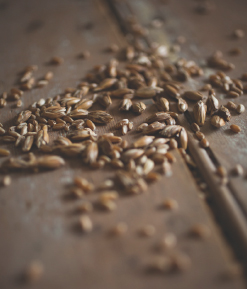
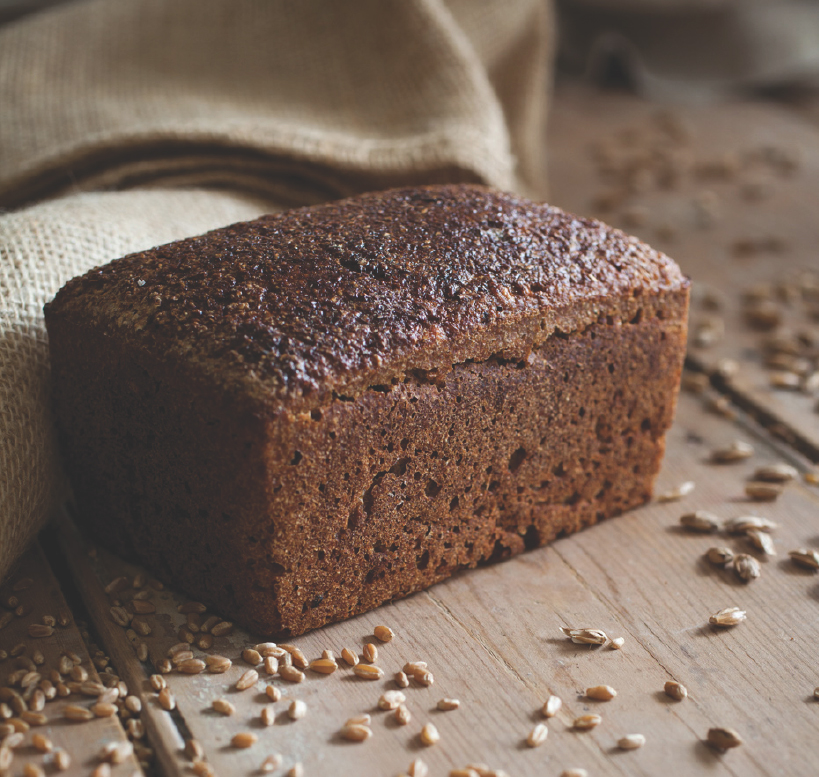
Neil Baldwyn and Amy Burnage launched Lucky 13 in 2011, later renaming it No. Thirteen Craft Bakers. He says, “It was the perfect time to convince like-minded businesses in Birmingham to ditch the commercial stuff and start using Real Bread.” The team and business continue to grow, on a mission to “work hard to build great relationships with our lovely customers, and to deliver the best bread we can”.
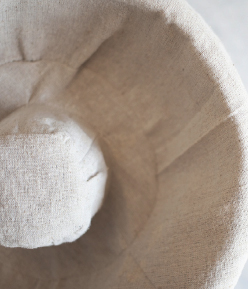
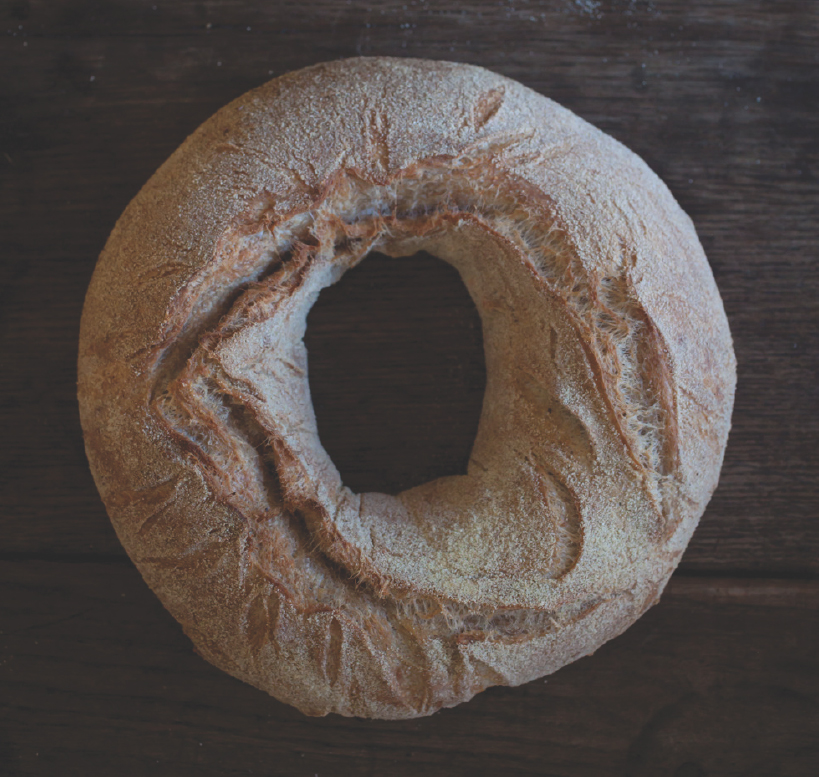
Semolina Crown NEIL BALDWYN
As Britain’s second city, it is surprising that Birmingham still only has a small handful of bakeries that have told us that they make what the Real Bread Campaign calls Real Bread. Neil and his partner Amy Burnage spotted this gap in the market back in 2011. This was one of the first breads Neil and Amy developed, and over their first few years he says it has remained a firm favourite among their Saturday specials.
MAKES: 1 loaf
FROM MIXING TO OVEN: 12-17 hours, or overnight plus 1-2 hours
BAKING TIME: 35 minutes
215g/7½oz/1½ cups white bread flour
150g/5½oz/2 cups fine semolina
65g/2¼oz/½ cup wholemeal/ wholegrain (dark) rye flour
280g/10oz/1¼ cups minus 1 tbsp water
85g/3oz/⅓ cup wheat or rye sourdough starter
45g/3 tbsp olive oil
8g/1½ tsp fine/table salt
1. Mix all of the ingredients except the salt together thoroughly. Cover the dough and leave at room temperature for 45 minutes.
2. Add the salt and knead for a few minutes to incorporate it fully into the dough. Cover and leave to rest for 20 minutes.
3. Give the dough a single fold, cover and leave to rest for 20 minutes. Repeat this fold and rest process three more times.
4. Lightly flour the work surface and turn the dough out onto it, seam-side up. Shape it into a ball, cover and leave to rest for 30 minutes.
5. Shape the dough into a ball again, cover and leave to rest for 10 minutes. Poke a hole through the middle, then using both hands, gently and smoothly increase the size of the hole until it is about 10cm/4in in diameter and doesn’t pull back. “Passing it through your hands like a rope works well for this”, suggests Neil.
6. Place the dough seam-side up in a well-floured, ring-shaped proving basket, or seam-side down on a floured or oiled baking sheet, cover and leave to prove in the refrigerator for 8-12 hours (typically overnight).
7. Remove the dough from the refrigerator and leave for 1-2 hours to come up to ambient temperature. Meanwhile, heat the oven to 250°C/230°C fan/480°F/gas 9+, or as high as it will go, with a baking stone or baking sheet in place.
8. Turn the dough out of the proving basket, or slide it off the baking sheet, seam-side down onto a dusted peel. Slide the dough onto the baking stone, then immediately turn the oven down to 220°C/200°C fan/425°F/gas 7. Bake for 20 minutes, then turn the loaf around to ensure even baking, and continue to bake for a further 15 minutes. If the loaf looks too pale or dark, turn the temperature up or down by 10°C/20°F accordingly.
Goats’ Cheese and Honey Maslin NICOLA WILLIS
Nicola said, “This loaf brings it all together: using time and the best local ingredients to make great Real Bread. The richness of the Welsh honey we use contrasts with the sharpness of the Ragstone cheese, all balanced by the light texture and gentle taste of the sourdough.” Ragstone is an unpasteurized lactic goats’ milk cheese, made in Herefordshire’s Golden Valley, and you should look for an artisanal chevre or something similar when you make this loaf.
MAKES: 1 loaf
FROM MIXING TO OVEN: overnight plus 6-8 hours
BAKING TIME: 35-40 minutes
FOR THE PRE-FERMENT:
90g/3¼oz/6 tbsp rye sourdough starter
60g/2¼oz/¼ cup water
120g/4¼oz/¾ cup plus 2 tbsp white bread flour
FOR THE DOUGH:
270g/9½oz/scant 2 cups white bread flour
150g/5½oz/scant ⅔ cup water
60g/2¼oz/½ cup wholemeal/ wholegrain (dark) rye flour
20g/generous 1 tbsp honey
5g/1 tsp fine/table salt
80g/2¾oz/⅓ cup soft goats’ cheese
20g/generous 1 tbsp honey, for drizzling
semolina or polenta/cornmeal, for dusting
1. Mix the pre-ferment ingredients together, cover and leave at room temperature overnight, or refrigerate overnight and bring it out 2 hours before needed.
2. Mix the pre-ferment and dough ingredients together, cover and leave to rest at room temperature for 10 minutes. Instead of kneading the dough, give it four separate single folds, with rests of 10-15 minutes after each fold, then leave the dough to prove for a further 1 hour.
3. Shape the dough carefully into a square about 1cm/½in thick. Break the cheese into pieces, distribute them evenly over the dough and gently press them in. Drizzle with honey.
4. Fold the 4 corners of the dough into the middle to cover the cheese, form the dough into a ball and seal the seams tightly.
5. Dust a proving basket well with semolina or polenta/cornmeal, shape the dough to fit and place it in, seam-side up. Cover and leave to prove for 4-6 hours at room temperature (alternatively, prove in the refrigerator overnight again, and remove 1 hour before baking).
6. Heat the oven to 240°C/220°C fan/475°F/gas 8-9, with a baking stone or baking sheet in place. Dust a peel with semolina or polenta/ cornmeal, turn the dough out onto it and slash along the middle of the top with a sharp knife, or if you feel confident, slash a pattern into the dough. Slide the loaf onto the baking stone. Bake for 35-40 minutes until the crust is golden, or darker if you prefer.
Nicola Willis joined The Bakers’ Table when it opened at the newly restored Talgarth Mill in Wales in 2011, and began baking professionally in 2012. The ethos of the business is to showcase high-quality, local ingredients and the café’s menu is based around Real Bread baked using flour from the watermill. Nicola now runs monthly baking classes to share her skills with enthusiastic amateurs.
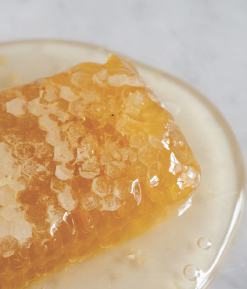
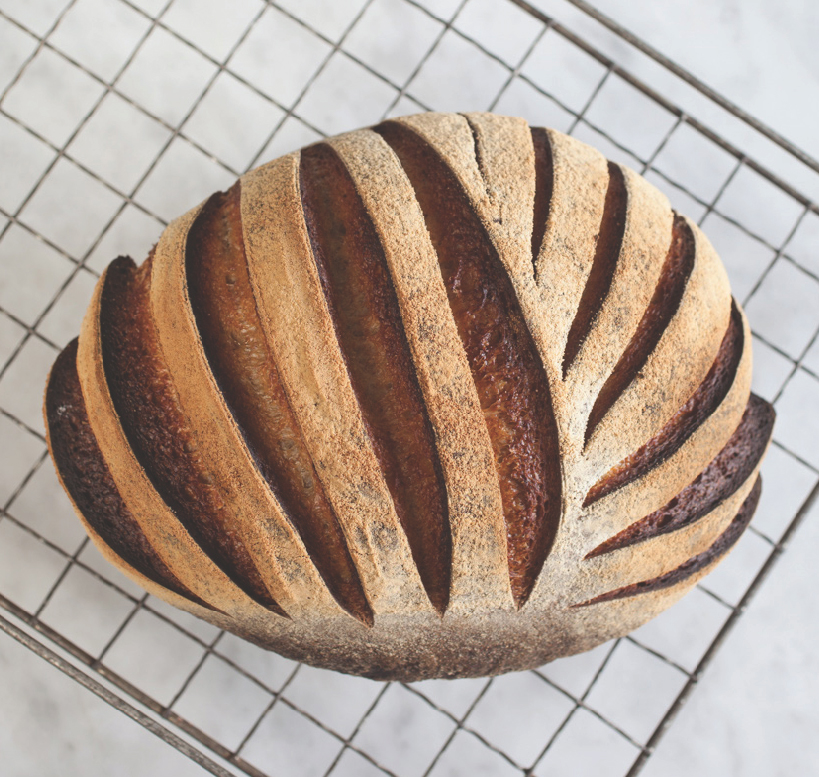
Hackney Wild Sourdough BEN MACKINNON
Through the Real Bread Campaign, I’ve met quite a few people who have said “Sod this”, quit their jobs, and become bakers. Ben MacKinnon is one of them. I first met Ben in the early days of his railway arch bakery, where he’d built an oven from salvaged materials. This is the basic recipe for the E5 Bakehouse’s signature sourdough. It depends on long, slow fermentation to develop a robust dough with a deep, complex flavour.
MAKES: 1 large loaf
FROM MIXING TO OVEN: 3 days
BAKING TIME: 40 minutes
FOR THE PRE-FERMENT:
35g/1¼oz/2½ tbsp wheat or rye sourdough starter
30g/1oz/2 tbsp water
40g/1½oz/4½ tbsp white bread flour
12g/½oz/3½ heaping tsp wholemeal/ wholewheat bread flour
FOR THE FIRST-STAGE DOUGH:
85g/3oz/⅓ cup water
125g/4½oz/¾ cup plus 2 tbsp white bread flour
30g/1oz/scant 3½ tbsp wholemeal/ wholewheat bread flour
FOR THE FINAL DOUGH:
215g/7½oz/1 cup minus 2 tbsp water
245g/8½oz/1¾ cups white bread flour
45g/1½oz/5 tbsp wholemeal/ wholewheat bread flour
8g/1½ tsp fine/table salt
1. Mix the pre-ferment ingredients together thoroughly, cover and leave in the refrigerator for 6 hours.
2. Add the first-stage dough ingredients to the pre-ferment and mix together thoroughly. Cover and leave in the refrigerator to ferment for 2 days, or until active and bubbling.
3. Add all of the final dough ingredients, except the salt, to the first-stage dough and mix together thoroughly. Cover and leave to rest for 30 minutes.
4. Add the salt and knead for a few minutes to mix it in thoroughly. Cover the dough and leave at room temperature for 2½ hours, giving it a single fold every 30 minutes.
5. Shape the dough to fit a large proving basket, flour both dough and basket well and place the dough in the basket, seam-side up. Cover and leave to prove in the refrigerator for 12 hours (typically overnight).
6. Heat the oven to 250°C/230°C fan/480°F/gas 9+, or as high as it will go, with a baking stone or baking sheet in place. Turn the dough out onto a well-floured peel, slash the top and slide it onto the baking stone. Bake for 40 minutes, turning the loaf around after 20 minutes to ensure even baking.
Ben MacKinnon became a baker in 2009, starting E5 Bakehouse using a pizza restaurant’s wood-fired oven and running a local home delivery round. In spring 2010, he built his own wood-fired rocket oven, fuelled by carpenters’ offcuts, in a railway/railroad arch. E5 runs entirely on renewable energy, delivers all products by bicycle and continues to evolve, for example by setting up its own small flour mill on site.
Multigrain Pain au Levain ROSS BAXTER
Levain is simply the French word for sourdough starter and pain au levain is bread made using it. Bread made with baker’s yeast is pain au levure.
MAKES: 1 large loaf
FROM MIXING TO OVEN: 14-18 hours, or overnight plus 6 hours
BAKING TIME: 30-35 minutes
FOR THE PRE-FERMENT:
50g/1¾oz/3½ tbsp white sourdough starter
30g/1oz/scant 3½ tbsp white bread flour
50g/1¾oz/heaping ⅓ cup wholemeal/ wholewheat bread flour
45g/1½oz/3 tbsp water
FOR THE SOAKER:
35g/1¼oz/¼ cup sunflower seeds
35g/1¼oz/¼ cup linseeds/flaxseeds
35g/1¼oz/¼ cup cracked rye
35g/1¼oz/⅓ cup rolled oats
8g/1½ tsp fine/table salt
65g/2¼oz/scant ½ cup wholemeal/ wholewheat bread flour
185g/6½oz/¾ cup water
FOR THE DOUGH:
265g/9¼oz/scant 2 cups wholemeal/ wholewheat bread flour
165g/5¾oz/¾ cup minus 1 tbsp water
sunflower seeds, for topping
1. Mix the pre-ferment ingredients together, cover and leave at room temperature for 8-12 hours (typically overnight). Mix the soaker ingredients together in a separate bowl, cover and also leave at room temperature for 8-12 hours. Towards the end of that time, mix the dough flour and water together, cover and leave for a 1-hour autolyse.
2. Add the soaker and pre-ferment to the dough and mix thoroughly, then knead until the dough is smooth and stretchy. Cover and leave at room temperature for 3 hours.
3. Shape the dough into a ball, cover and leave to rise for 30 minutes.
4. Reshape the loaf, wet the top slightly and roll it in sunflower seeds. Place seam-side up in a large floured proving basket, cover and leave to prove for 2 hours.
5. Put a large casserole dish/Dutch oven or other heavy, ovenproof, lidded cooking pot in the oven and heat to 230°C/210°C fan/450°F/ gas 8. Using a heatproof cloth or oven gloves, lift the pot out onto a safe working area that the base of the pan won’t scorch.
6. Carefully turn the dough seam-side down into the pot, slash the top of the dough, place the lid on, put it back in the oven and bake for 20 minutes. Remove the lid and continue to bake for a further 10-15 minutes.
Ross Baxter’s surname has its roots in the Old English for baker and he comes from a family of them. In 2011, he became head baker of the community-owned co-operative Bakery Dunbar. Since spring 2014 he has led the team at Bostock Bakery in North Berwick. He says, “We are extremely passionate about everything we do and one thing we do really well is bake bread, Real Bread; bread that comforts you and gives you a big hug; bread that just tastes really damn good!”
Sungmo Kim started to learn to bake while at university. Later, while enjoying baking Real Bread for his family, he pictured that this could become his job. He bought a small oven and in April 2015 converted a space at his home in Daegu, South Korea, to launch Loaf and Salt Bakehouse microbakery.
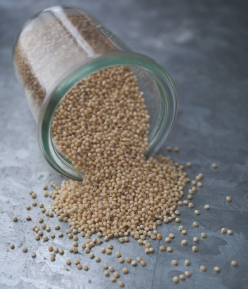
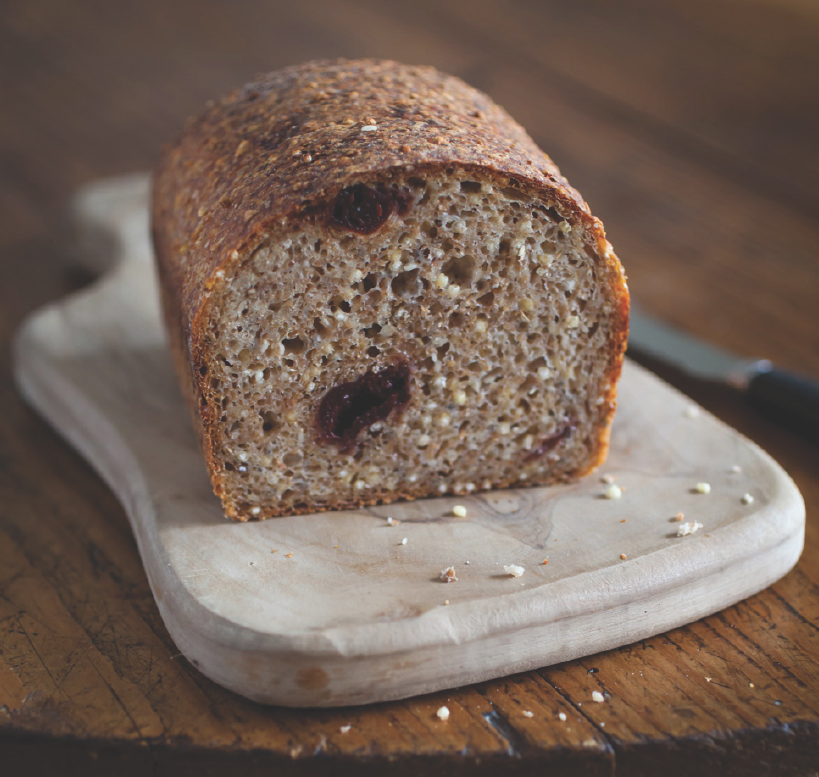
Millet Porridge and Wheat Loaf SUNGMO KIM
Millet is an important food crop, notably in south and east Asia and sub-Saharan Africa. In Korea, it is often made into a porridge, and that’s how it is used in this recipe. Don’t confuse the whole anise seeds used here (from the herbaceous annual Pimpinella anisum) with the star anise used in Chinese and Indian cooking.
MAKES: 1 loaf
FROM MIXING TO OVEN: 3 days
BAKING TIME: 35-40 minutes
FOR THE PRE-FERMENT:
45g/1½oz/5 tbsp brown bread flour (or half white, half wholemeal/ wholewheat)
45g/1½oz/3 tbsp water
5g/1 tsp wholemeal/wholewheat sourdough starter
FOR THE MILLET PORRIDGE:
45g/1½oz/¼ cup millet
85g/3oz/⅓ cup water
FOR THE DOUGH:
180g/6¼oz/¾ cup water
85g/3oz/½ cup plus 1 tbsp brown bread flour (or half white, half wholemeal/wholewheat)
135g/4¾oz/scant 1 cup wholemeal/ wholewheat bread flour
4g/¾ tsp fine/table salt
5g/1 tsp chia seeds
30g/1 oz/scant ¼ cup dried cherries
2-3g/½-¾ tsp anise seeds
15g/½oz/2 tbsp sesame seeds
butter or oil, for greasing
1. Mix the pre-ferment ingredients together, cover and leave at room temperature for about 16-18 hours (typically until the next day) until bubbly.
2. Put the millet and water into a pan, bring to the boil, then reduce the heat, cover and simmer until the water has been absorbed by the millet. Leave the porridge to cool and refrigerate until needed.
3. Mix the pre-ferment with the water and both flours from the dough recipe. Cover and prove in the refrigerator for a further 24 hours.
4. Mix the salt into the dough until fully incorporated. Cover and leave to rest at room temperature for 20 minutes. Give the dough a single fold, cover and leave to rest for another 20 minutes.
5. Add the millet porridge and remaining dough ingredients and mix thoroughly. Cover and leave to rest for 20 minutes.
6. Give the dough another single fold, rest it for 20 minutes, give it one final single fold, then cover and leave the dough to rise at room temperature for 4-5 hours.
7. Grease a large loaf tin, shape the dough to fit and place seam-side down in the tin. Dust the top of the dough with flour, cover and leave to prove in the refrigerator for 12-16 hours (typically until the next day.)
8. Take the dough out of the refrigerator 1-2 hours before baking. Heat the oven to 240°C/220°C fan/475°F/gas 8-9 and bake the loaf for 35-40 minutes, checking after about 15 minutes that it isn’t browning too quickly: turn the oven down to 220°C/200°C fan/425°F/gas 7 if it is.
Apple Sourdough ROB TAYLOR
Rob tells us that this recipe was originally created by Matthew McCarthy, who was his mentor when he first joined The Welbeck Bakehouse team. Since then, it has remained a firm favourite for staff and customers alike. It makes an incredible bacon sandwich and cheese on toast to die for.
MAKES: 2 loaves
FROM MIXING TO OVEN: 5-7 hours, or overnight plus 2 hours
BAKING TIME: 25-30 minutes
200g/7oz/2 cups unpeeled, cored and thinly sliced dessert apple, for drying
200g/7oz/2 cups unpeeled, cored and diced dessert apple, for cooking
12g/5 tsp ground mixed spice/ pumpkin pie spice
300g/10½oz/2 cups plus 2 tbsp strong white bread flour
40g/1½oz/⅓ cup wholemeal/ wholegrain (dark) rye flour
40g/1½oz/scant ⅓ cup wholemeal/ wholewheat bread flour
270g/9½oz/1 cup plus 2 tbsp hand-warm water
115g/4oz/scant ½ cup white sourdough starter
8g/1½ tsp fine/table salt
butter or oil, for greasing
1. Lay the sliced apple on a baking sheet lined with non-stick baking parchment and bake at 140-150°C/120-130°C fan/275-300°F/gas 1-2 until 80-90% dehydrated: dry but not crispy. Separately, cook the diced apple in a pan until soft but not mushy. Leave both to cool, then measure 75g/2½oz/scant 1 cup dried apple and 150g/5½oz/1 cup cooked apple into a bowl and fold in the mixed spice/pumpkin pie spice.
2. Put all three flours into a large bowl, add the water and mix together thoroughly until no lumps or dry patches remain. Cover and leave for 1 hour, then add the sourdough starter and salt and knead for 5-7 minutes or until the dough is fully and evenly mixed together.
3. Add the apple/spice mixture and knead that into the dough as well. If the dough appears to be too dry or too wet, add a little water or flour to adjust this, and knead it in. Place the dough in a lightly greased bowl, at least 50% larger than the dough itself. Cover and leave to rise in a warm draught-free place for 2½-3 hours, giving the dough a single turn every 50-60 minutes.
4. Divide the dough into 2 equal-size pieces and shape them into balls. Place seam-side down on baking sheets dusted with a little flour, or seam-side up in floured proving baskets. Cover and leave to rise by 40-50% at room temperature, or more slowly in the refrigerator overnight, taking them out 1-2 hours before baking.
5. Heat oven to 230-240°C/210-220°C fan/450-475°F/gas 8-9. If you are using proving baskets, have a baking stone in place in the oven, and when ready to bake, turn the dough out onto a floured peel, slash the top of the dough and slide it carefully onto the stone. It may be easier to do this one loaf at a time. If using baking sheets, simply slash the dough before transferring to the oven on the baking sheets. Bake for 25-30 minutes.
Rob Taylor was a pastry chef and keen amateur baker before joining The Welbeck Bakehouse in 2013. With a passion for sourdough and viennoiserie and an eagerness to learn, Rob became head baker in 2014 and is supported by an incredibly hard-working and passionate team.
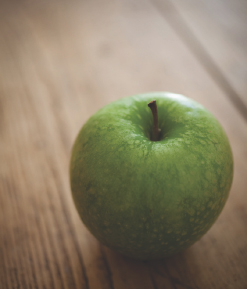
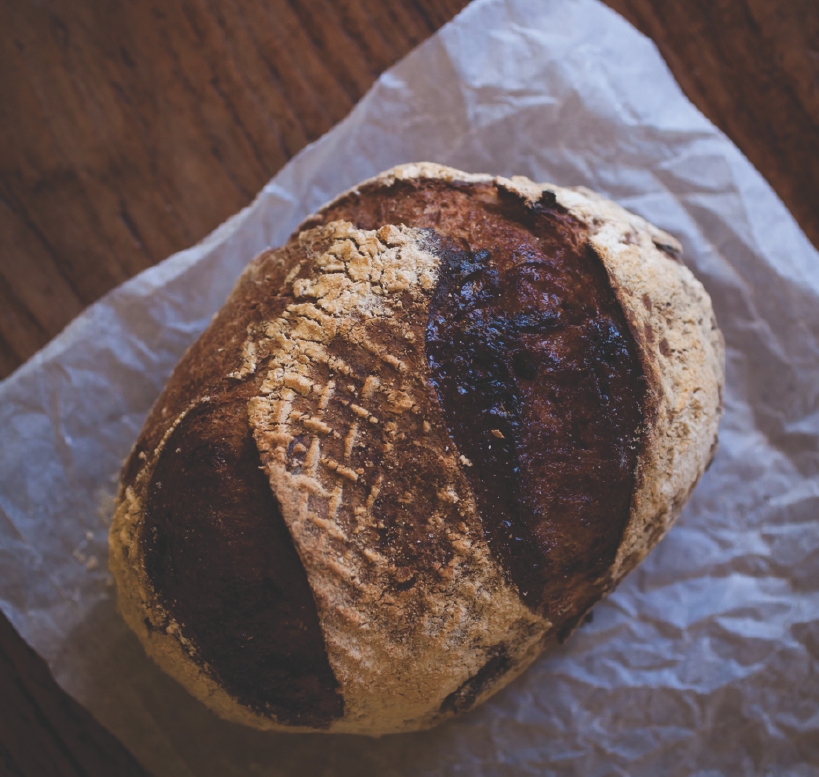
Buttermilk Rolls MATTHEW ROBERTS
Matthew tells me that buttermilk was a mainstay of traditional Scottish baking, and that one of its effects is that it helps to soften the crumb of the bread. Once made from the fermented whey left over at the end of butter making, it’s now usually produced by inoculating skimmed milk with a culture of lactic acid bacteria.
MAKES: 12 rolls
FROM MIXING TO OVEN: overnight plus 4-5 hours
BAKING TIME: 15 minutes
FOR THE PRE-FERMENT:
60g/2¼oz/¼ cup rye sourdough starter
130g/4½oz/½ cup plus 2 tsp water
130g/4½oz/scant 1¼ cups wholemeal/ wholegrain (dark) rye flour
FOR THE DOUGH:
325g/11½oz/2⅓ cups wholemeal/ wholewheat bread flour
325g/11½oz/scant 2½ cups plain/ all-purpose flour
325g/11½oz/1⅓ cups water
170g/6oz/scant ¾ cup buttermilk
20g/1½ tbsp butter, plus extra for greasing
15g/3 tsp fine/table salt
1. Mix the pre-ferment ingredients together, cover and leave at room temperature overnight.
2. The next day, mix the flours, water and buttermilk for the dough together thoroughly. Cover and leave to rest for 20 minutes.
3. Warm the butter until it is barely melted, then mix it into the dough with the salt and the pre-ferment and knead for 5 minutes. Cover and leave to rest for 10 minutes. Knead the dough for another 5 minutes, rest again for 10 minutes, then give it one more 5-minute knead. You should have a smooth, stretchy dough. Cover and leave to rest for another 20 minutes.
4. Give the dough a single fold, cover and leave to rest for 20 minutes, then repeat this fold and 20-minute rest.
5. Grease a baking sheet with butter. Divide the dough into 12 equalsize pieces and shape them into balls. Place on the sheet about 5cm/2in apart, leaving room for them to grow (or closer, if you want to bake “batch” rolls that gently join together). Dust the tops with flour, cover and leave to prove at room temperature for 2 hours.
6. Heat the oven to 250°C/230°C fan/480°F/gas 9+, or as high as it will go. Put the rolls into the oven on the baking sheet, immediately turn the oven down to 220°C/200°C fan/425°F/gas 7 and bake for around 15 minutes until golden brown.
Matthew Roberts began to bake for himself and his family when the only Real Bread baker in the area stopped selling through his local market. After Matthew and his wife Zillah moved to Scotland, a regular order from a nearby deli encouraged the couple to begin expanding their bakery, and so began the Steamie Bakehouse. In September 2013, the couple relocated to Yorkshire, where Matthew joined the team at Seven Hills Bakery.
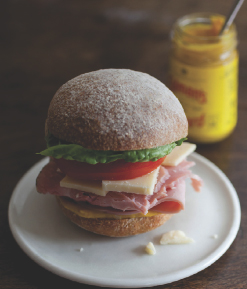
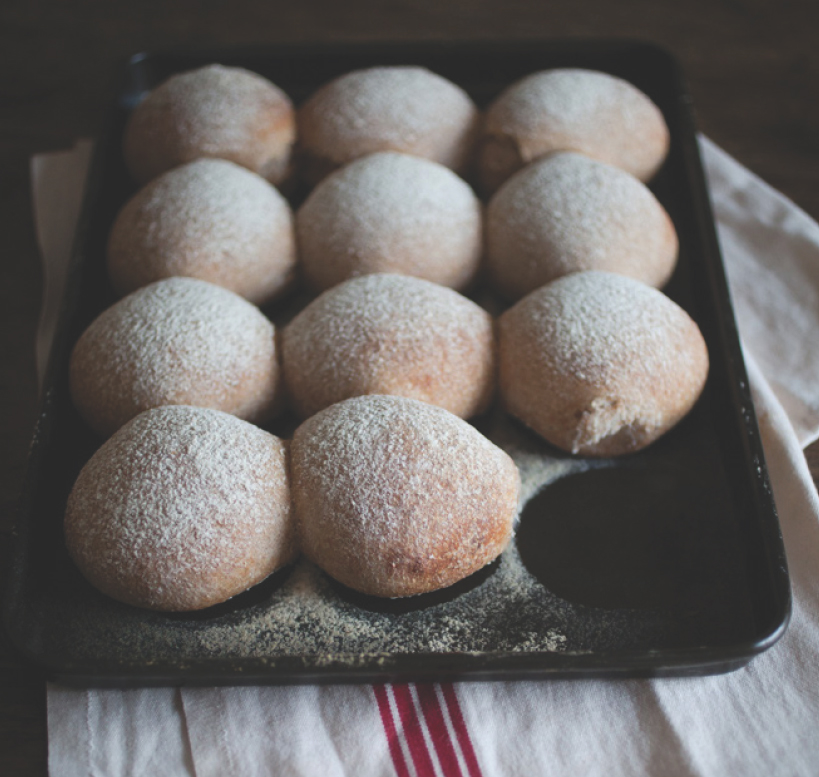
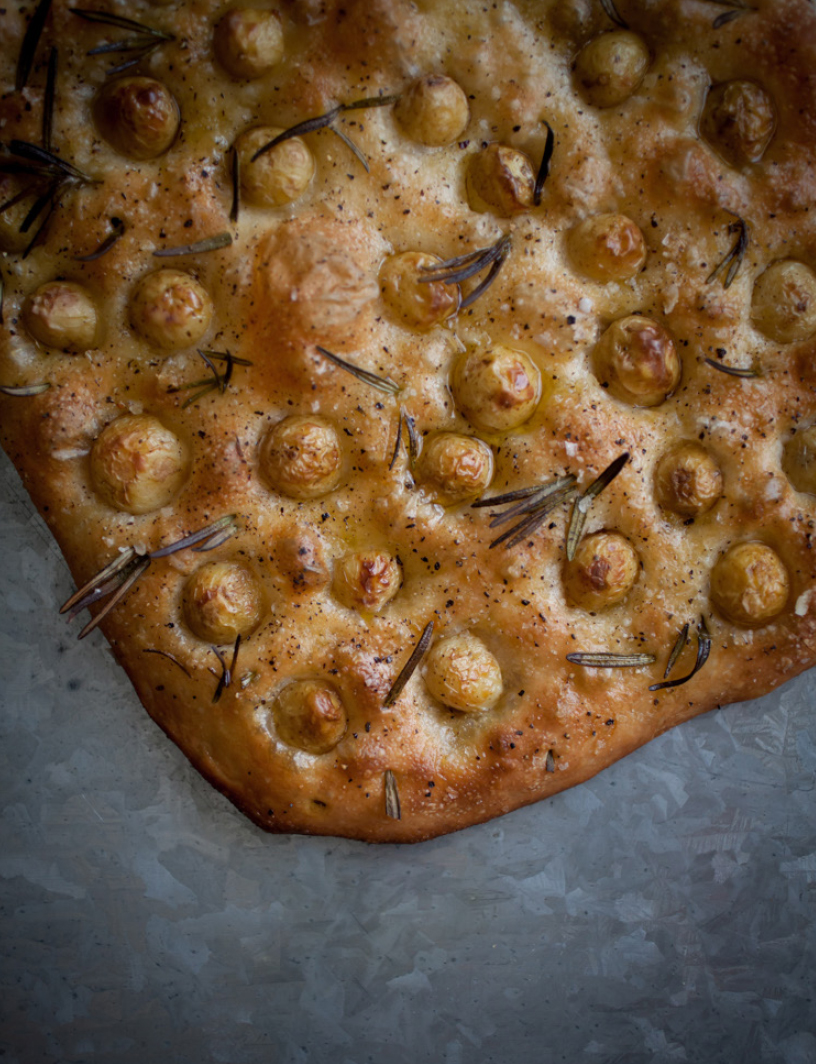
Potato, Rosemary and Cracked Pepper Focaccia MARK WOODS
The Latin for “hearth” is focus, where a whole family of flattish breads including focaccia and fougasse were once baked, and from which they take their names. If you have a wood-fired pizza oven, this is one to try in it. Or like me, you can bake in a regular domestic oven.
MAKES: 1 loaf
FROM MIXING TO OVEN: 3½-6 hours
BAKING TIME: 15-20 minutes
FOR THE DOUGH:
50g/1¾oz/3½ tbsp white sourdough starter
150g/5½oz/about 1 cup white bread flour
150g/5½oz/1 cup plus 2 tbsp tipo 00 bread flour
150g/5½oz/scant ⅔ cup water
50g/1¾oz/3½ tbsp olive oil, plus a little extra for greasing and brushing
FOR THE TOPPING:
300g/10½oz/2⅓ cups baby new potatoes
5cm/2in sprig of rosemary
15-20 pairs of rosemary leaves
coarse sea salt flakes
freshly ground black pepper
1. Mix all of the dough ingredients together thoroughly. Cover and leave to rest for 10-15 minutes.
2. Knead the dough until smooth and stretchy. Cover and leave to prove at room temperature for 1-2 hours.
3. Meanwhile, cook the potatoes and sprig of rosemary in a pan of boiling water for 10-15 minutes until the potatoes are just soft. Drain, leave to cool and cut each potato in half, discarding the rosemary.
4. Grease a large baking sheet (flat or with sides up to 3cm/1¼in high) lightly with olive oil.
5. Turn the dough out onto a lightly floured or oiled work surface and shape into a rectangle about 2cm/¾in thick, to fit the baking sheet. You may find it easier to do this in two stages, leaving the dough to relax for 5-10 minutes in between.
6. Place the dough on the baking sheet and brush lightly with olive oil. Cover and leave to prove at room temperature for 2-3 hours.
7. Heat the oven to 230°C/210°C fan/450°F/gas 8. Push the potato pieces cut-side down into the dough, jab small holes into the dough and push in the rosemary leaves, then sprinkle with salt flakes and black pepper. Bake for 15-20 minutes, or until light golden brown. Serve when just cool.
Appam CHRIS YOUNG
This is a breakfast staple in southern India, traditionally made using the palm sap known locally as toddy, and left to ferment overnight. They are cooked in a shallow, concave pan called an appachatti, but you can use a frying pan, skillet or heavy wok. Make the rice sourdough starter in exactly the same way as a white sourdough starter (see page 14), using brown rice flour for at least the first one or two days. After that you can use white rice flour.
MAKES: 5-10, depending on size
FROM MIXING TO COOKING: overnight plus a few minutes
COOKING TIME: 2-4 minutes each
500g/1lb 2oz/2¾ cups white long grain rice
250g/9oz/generous 1 cup thick coconut milk
50g/1¾oz/3½ tbsp rice sourdough starter
15g/½oz/1 tbsp grated jaggery or soft dark brown sugar
5g/1 tsp fine/table salt
coconut or vegetable oil, for frying
1. Soak half the rice in water for 4-5 hours before draining it thoroughly. Meanwhile, cook the remaining rice in a pan of boiling water for about 15 minutes until soft, then drain that as well.
2. Grind both batches of rice with the coconut milk in a mortar and pestle, food blender or processor to make a smooth paste. Leave to cool slightly, then add the sourdough starter and continue to purée for about 5 minutes or until you have a thick, smooth batter. Cover and leave to ferment at room temperature overnight until it is bubbling, or even seething.
3. Add the jaggery and salt to the batter and mix well.
4. Lightly oil an appachatti and warm over a medium heat for a few minutes. Pour in a ladleful of batter, swirl it around to make a circle about 15cm/6in in diameter and 5mm/¼in thick at the middle and cook for a few minutes until it is set and cooked through. The idea is to have it thick in the middle and very thin at the edges, which gives it a spongy centre and a lacy, lightly browned crispy fringe. Remove with heatproof tongs and repeat with the remaining batter until it is all used up.

Baker’s Tip As an alternative to coconut milk, use equal weights of water and fresh or desiccated/dried shredded coconut.
Sourdough Pitta JACK SMYLIE WILD
Pitta shares its heritage, and etymology, with pizza, pide and other low-risen breads found from eastern Europe to the Levant. To create the “pocket” that pitta is known for, a really good thwack of bottom heat is essential, from an oven with a stone floor or a really hot baking stone in it. With that, the oven spring in such a thin dough will push it to form a single bubble. Jack says, “Stuff them with falafel, slaw, hummus, harissa, minty yogurt and grilled halloumi.”
MAKES: 6 pittas
FROM MIXING TO OVEN: 5½-7 hours
BAKING TIME: 2-4 minutes each batch
315g/11oz/2¼ cups white bread flour
210g/7½oz/1 cup minus 2 tbsp water
70g/2½oz/5 tbsp wholemeal/ wholewheat sourdough starter
5g/1 tsp fine/table salt
semolina, for dusting (optional)
1. Mix the flour, water and sourdough starter together thoroughly. Cover and leave at room temperature for 1 hour.
2. Stretch the dough out, sprinkle the salt over it and work it in for a few minutes to make sure it’s evenly distributed and starting to dissolve. Knead the dough for 5-10 minutes, then cover and leave to prove at room temperature for 3-4 hours until pillowy.
3. Dust the work surface with semolina or flour. Divide the dough into 6 equal-size pieces, shape them into balls, place on the dusted work surface, cover and leave to prove for 40-60 minutes.
4. Heat the oven to 250°C/230°C fan/480°F/gas 9+, or as high as it will go, with a baking stone or baking sheet in place. Roll out each ball of dough to an oval about 5mm/¼in thick. Cover and leave to rest for 5-10 minutes.
5. Using a floured peel, slide as many of the pittas as will fit onto the hot baking stone. Bake for 2-4 minutes until puffed up, without letting them brown or crisp. Wrap in a clean dish towel while cooling so that the escaping steam stays close to the pittas and helps to keep them supple, while you bake the remaining pieces of dough.
Jack Smylie Wild is a self-taught sourdough fanatic. Having grown up in Devon, he returned to his native Wales, where he soon became frustrated by the lack of Real Bread on offer. Always a keen cook, he decided to take matters into his own hands and set up his bakehouse café Bara Menyn (literally “bread and butter”) in Cardigan in February 2015. He says his meticulous approach to the sourdough process quickly gained a loyal following of Real Breadheads.
Sourdough Pizza Margherita OTTAVIA MAZZONI
I met Ottavia on the course at Schumacher College that first led me to the Real Bread Campaign. She says that this recipe is the result of years of attempts at making a good sourdough pizza suitable for baking in a domestic oven. She reckons that this one is the best yet.
MAKES: 4 thin pizzas
FROM MIXING TO OVEN: 9-11 hours
BAKING TIME: 4-5 minutes each
FOR THE DOUGH:
150g/5½oz/⅔ cup white sourdough starter
250g/9oz/1 cup plus 1 tbsp water
350g/12oz/2⅔ cups plain/ all-purpose flour
50g/1¾oz/¼ cup fine durum wheat semolina
5g/1 tsp fine/table salt
15g/1 tbsp olive oil
FOR THE TOPPING:
125g/4½oz mozzarella
400g/14oz/1¾ cups canned chopped tomatoes
a generous pinch of dried oregano
olive oil, to taste
salt and freshly ground black pepper
a handful of basil leaves
1. Mix the starter with 200g/7oz/¾ cup of the water and 250g/9oz/ scant 2 cups of the flour. Cover and leave at room temperature for about 4 hours.
2. Add in half of the remaining water, the rest of the flour and the semolina, salt and olive oil and mix thoroughly. Cover and leave to rest for 10 minutes. If the dough is feeling tight (it should be quite soft and stretchy) add in more of the water. Knead the dough until it loses its stickiness and becomes smooth and elastic. Shape into a ball, cover and leave to prove at room temperature for 2-3 hours.
3. Divide the dough into 4 equal-size pieces, shape into balls. Place these on a work surface or baking sheet dusted with semolina, cover and leave to prove for another 2-3 hours.
4. If you have a pizza oven, fire it up! Otherwise, place a baking stone on the top shelf of the oven and heat it up, as hot as it will get: 250°C/230°C fan/480°F/gas 9+. Meanwhile, drain the mozzarella, slice it thinly and pat off any excess liquid with paper towels. Pour the chopped tomatoes with their juices into a bowl and season with oregano, olive oil, salt and pepper to taste.
5. Flatten each ball of dough on a floured work surface, patting it down with your hands, starting from the middle and letting the dough spread gently, leaving a slightly risen border around the edge. You might need to do this in two stages with a 5-minute rest in between.
6. Transfer 1 base onto a well-floured peel. Top with tomatoes followed by slices of mozzarella, then drizzle with olive oil. Slide the pizza onto the baking stone, trying not to disturb the filling. Bake until done, which hopefully won’t take more than about 4-5 minutes, so keep an eye on it. Repeat with the remaining pizza bases. Serve with a scattering of basil leaves and a twist of pepper.
Ottavia Mazzoni is an Italian home baker and cookery teacher based near Bath in the west of England, where she moved in 2001. A keen cook and baker since childhood, in 2010 she set up Ottavia in Cucina cookery and baking school to share her passion for good, uncomplicated food and Real Bread. She also founded the Box Community Sourdough Project, a not-for-profit skill share scheme based in the village of Box, on a mission to teach as many people as possible how to make genuine sourdough bread.
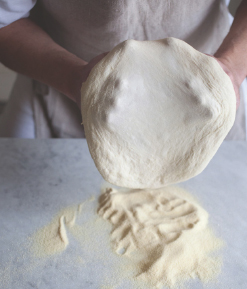

Sourdough Pretzels URSI WIDEMANN
Ursi says, “I love pretzels! I could eat them every single day … maybe it’s because I’m Bavarian”. Pretzels are usually dipped in a solution of sodium hydroxide (lye) prior to baking, which gives them their characteristic taste and shiny brown skin. As food-grade sodium hydroxide can be hard to obtain and is hazardous to handle, this recipe uses bicarbonate of soda/baking soda instead, which gets you safely toward a similar result.
MAKES: 12
FROM MIXING TO OVEN: 12-16 hours
BAKING TIME: 15-20 minutes
FOR THE PRE-FERMENT:
125g/4½oz/¾ cup plus 2 tbsp wholemeal/wholewheat bread flour
20g/1½ tbsp rye sourdough starter
100g/3½oz/½ cup minus 1 tbsp water
FOR THE DOUGH:
375g/13oz/2⅔ cups white bread flour
25g/1oz/2 tbsp butter
8g/1½ tsp fine/table salt
160g/5¾oz/⅔ cup water
FOR DIPPING:
1kg/2lb 4oz/4¼ cups water
20g/heaping 1½ tbsp bicarbonate of soda/baking soda
FOR THE TOPPING:
coarse sea salt flakes or crystals, or you could use sesame seeds, poppy seeds or caraway seeds
1. Mix the pre-ferment ingredients together, cover and leave at room temperature for 8-12 hours until bubbly.
2. Mix the dough ingredients with the pre-ferment, and knead until you have a firm but supple dough: tighter than usual, but if it really is too stiff to work, add a little more water. Put the dough into a bowl, cover and leave to rise at room temperature for a further 3 hours, giving the dough a single fold halfway through this time.
3. Divide the dough into 12 equal-size pieces (65g/2¼oz), roll into balls, cover and leave for 20 minutes, then roll each piece into a strand about 25cm/10in long that tapers at the ends with a little belly in the middle. Bend each strand into a “U” shape, cross one side over the other about halfway up (fig. 1), give it a twist where they cross (fig. 2), then fold the ends up to meet the bend of the U and press down gently to fix in place (fig. 3). Cover the dough and leave to prove for 45-60 minutes.
4. Line a baking sheet with non-stick baking parchment and heat the oven to 230°C/210°C fan/450°F/gas 8. Meanwhile, bring the water to the boil in a large pan and add the bicarbonate of soda/baking soda. Drop the pretzels into the boiling liquid 2 or 3 at a time for 20 seconds, lift out with a slotted spoon and place onto the baking sheet. Immediately sprinkle with the topping of your choice while the dough is still tacky. Slash the dough at its fattest part and bake for 15-20 minutes until deep brown.
Ursi Widemann set up The Little Bear microbakery in the kitchen of her London home. Originally from Germany, her Real Bread adventures have included a Bread Angels course and stints at Baker and Spice in Dubai and the Biohotel Kurz in Berchtesgaden, Germany.

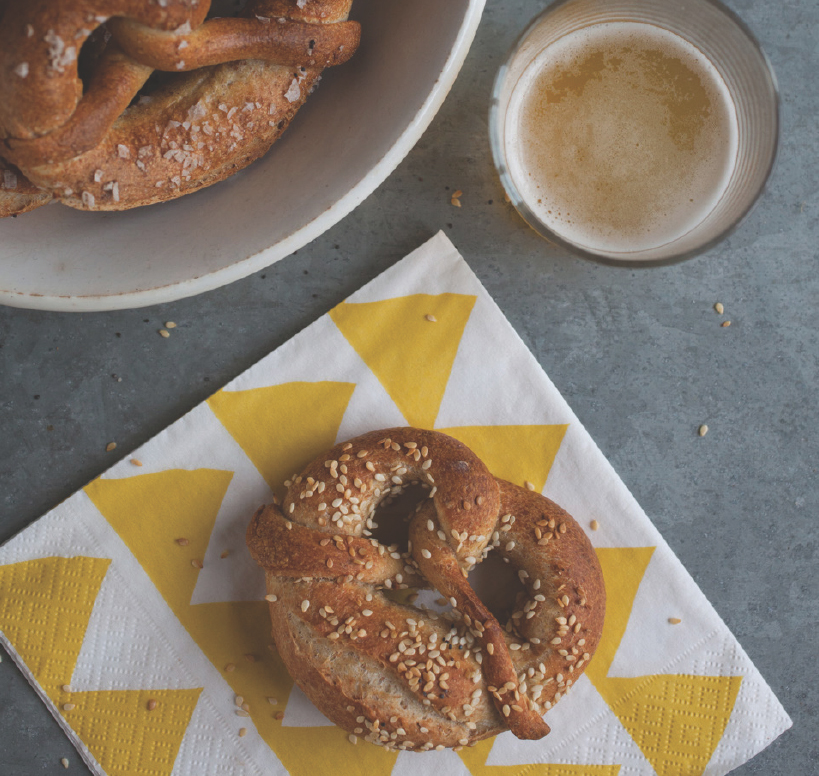
Crumpets PETER COOK
Real crumpets are amazing! Used instead of an English muffin as the foundation of eggs Benedict, or simply toasted and spread liberally with butter that melts and dribbles down your fingers and served with a steaming mug of tea, they are “the business”. Peter created this recipe while he was head baker at S.C. Price in Ludlow, inspired by one used in the 1940s by the bakery’s founder Sid Price.
MAKES: up to 20, depending on size
FROM MIXING TO COOKING: overnight plus 3-4 hours
COOKING TIME: 8-9 minutes per batch
200g/7oz/1½ cups minus 1 tbsp white bread flour
200g/7oz/1½ cups plain/all-purpose flour
200g/7oz/¾ cup plus 1 tbsp white sourdough starter
200g/7oz/¾ cup plus 1 tbsp milk
200g/7oz/¾ cup plus 1 tbsp water
10g/2 tsp fine/table salt
10g/2 tsp vegetable oil
5g/1 tsp caster/superfine sugar
5g/1 tsp fresh yeast
110g/3¾oz/scant ½ cup sparkling water
butter or oil, for greasing
1. Mix all of the ingredients together, except the sparkling water, cover and leave in the refrigerator overnight.
2. Remove the bowl from the refrigerator, stir the batter, cover and leave at room temperature for 3-4 hours, or until many bubbles appear on the surface.
3. Lightly grease a griddle or heavy frying pan and as many 8.5cm/ 3¼in crumpet rings as will fit onto it. Place over a medium-high heat.
4. Stir the sparkling water into the batter and ladle some of the batter into each ring to a depth of no more than 1cm/½in.
5. Cook each crumpet for 6-7 minutes until bubbles rise to the surface and burst to leave holes and the batter has set. The trick is to get the temperature hot enough to set the crumpets before the holes start to collapse, but not so hot that their bottoms burn before they are cooked throughout (you may want to cook one “test crumpet” before going for a pan full!).
6. Remove the rings, flip the crumpets over and cook for a few minutes more until they are lightly browned. Re-grease the rings before cooking the next batch.

Sippet: Etymologists can’t agree on the origin of the word crumpet. Theories include it coming from the Welsh crempog or Breton krampouz, or possibly having the same Germanic root as crumple.
Peter Cook began baking in 1991 at S.C. Price & Sons in Ludlow, Shropshire, where he helped the bakery to win national plaudits, including from Waitrose, the World Bread Awards and Baking Industry Awards. In 2014 Peter moved to Ledbury and started Peter Cooks Bread with Bread Angel, Shona Kelly. The wholesale bakery supplies businesses in Herefordshire and Worcestershire and in 2014 were the overall winners of the World Bread Awards for their ciabatta.
Chestnut Muffins SIMON POFFLEY
Simon originally created these chestnut flour English muffins when he was a member of a now-disbanded bakers’ collective, which ran a fortnightly stall at a farmers’ market in Stoke Newington, east London. He says that they always used to “stash some away for a post-market toasting, spread with chestnut purée if possible!”
MAKES: 12 English muffins
FROM MIXING TO COOKING: overnight plus 2-3 hours
COOKING TIME: 15 minutes per batch
115g/4oz/scant ½ cup white sourdough starter
300g/10½oz/scant 1½ cups plain yogurt
170g/6oz/scant ¾ cup water
225g/8oz/2½ cups chestnut flour
500g/1lb 2oz/3½ cups white bread flour (or about 550g/1lb 4oz/4 cups wholemeal/wholewheat bread flour)
10g/2 tsp fine/table salt
rice flour or semolina, for dusting
1. Mix all of the dough ingredients together thoroughly. Cover and leave to rest at room temperature for 15 minutes, then knead for about 10 minutes. Cover and leave to prove for 1 hour, then give the dough a single fold. Cover and leave to prove in the refrigerator overnight (12-14 hours).
2. Remove the dough from the refrigerator about 2-3 hours before baking. After 1 hour, give the dough a double fold, then leave it to relax for at least 15 minutes. Dust the work surface with rice flour or semolina and roll the dough out to about 1cm/½in thick. Cut the dough into circles using an 8.5cm/3¼in cookie cutter or a crumpet/ poached egg ring. Dust excess flour from the offcuts and press them together, leaving the dough to rest again before rolling out and cutting more muffins, until it is all used up.
3. Dust the unbaked muffins with more rice flour or semolina, cover and leave to prove at room temperature for 1 hour. Heat a griddle or heavy frying pan over a medium-high heat. Place 3 or 4 muffins in the pan and cook for about 10 minutes, lifting with a spatula every few minutes to check that they are not over-browning. Flip them over and cook for about another 5 minutes until browned on both sides. Place on a wire cooling rack. When cool, the muffins can be split, toasted and buttered.
Simon Poffley started baking sourdough loaves to recreate the breads he’d eaten in Russia, Poland and Germany. From 2010 to 2013, he was part of the Hornbeam Bakers’ Collective, before moving on to found The Fermentarium, home to sourdough classes, pizza baking in a cob oven and the Left Bank Brewery, as part of delving into other fermentation techniques.
Wayne Caddy is Head of Baking at the School of Artisan Food and owner of The Essential Baker. Having trained at Sheffield and Leeds colleges, he was awarded Student Baker of the Year. Over more than 20 years, he has baked all over the world, sharing his knowledge of all things Real Bread. Wayne has represented the UK at the baking Coupe du Monde, and more recently was the first baker from the UK to compete in the prestigious Masters de la Boulangerie; only a handful of the top bakers from around the world are selected.
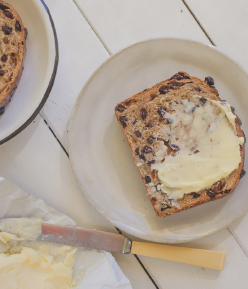
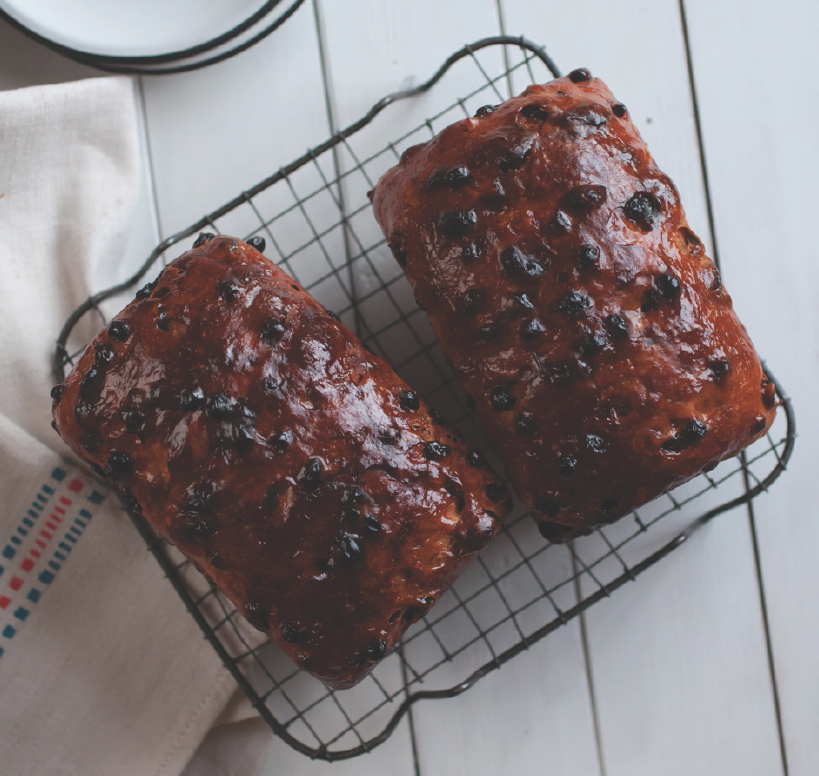
Bara Brith WAYNE CADDY
Bara brith is Welsh for “speckled bread”, and as with so many recipes from around the world, there are probably nearly as many versions as there are towns and villages or even families in its homeland. Wayne has eschewed the baker’s yeast often used and says that “the sourdough provides a subtle flavour, which works to complement the other ingredients”. He adds, “packed with fruit and lightly spiced, this iconic Welsh tea loaf is best served with delicious real butter”.
MAKES: 2 small loaves
FROM MIXING TO OVEN: 6½-10½ hours
BAKING TIME: 45 minutes
FOR THE PRE-FERMENT:
50g/1¾oz/heaping ⅓ cup wholemeal/ wholewheat bread flour
50g/1¾oz/heaping ⅓ cup white bread flour
65g/2¼oz/¼ cup whole milk
100g/3½oz/scant ½ cup firm white sourdough starter (60% hydration)
FOR THE DOUGH:
240g/8½oz/1 cup whole milk
240g/8½oz/about 1¾ cups white bread flour
5g/1 tsp fine/table salt
60g/2¼oz/scant ⅓ cup packed soft brown sugar
35g/1¼oz/2 tbsp lard
35g/1¼oz/2 tbsp butter, plus extra for greasing
230g/8oz/1¾ cups currants
100g/3½oz/½ cup sultanas/golden raisins
30g/1oz/scant ¼ cup mixed peel/ candied peel
3g/½ tsp ground mixed spice/pumpkin pie spice
FOR THE GLAZE:
1-2 tbsp apricot jam, diluted with a little boiling water
1. For this recipe, you need to create a sourdough starter at 60% hydration: 3 parts water (by weight) to every 5 parts flour (e.g. 75g/3oz/ 5 tbsp water to every 125g/5oz/¾ cup plus 2 tbsp flour). You can do this from day one, or adapt an existing starter with several refreshments in this ratio.
2. Mix the pre-ferment ingredients together. Cover and leave in a warm place (35-40°C/95-105°F) for 2-3 hours, or longer in a cooler place, until it becomes puffy.
3. Add the milk, flour and salt to the pre-ferment, mix thoroughly and knead until you have a smooth, stretchy dough, then add the sugar, lard and butter to the dough and continue kneading until they are worked into the dough and it is smooth and silky again.
4. Mix together the dried fruits and spice. Flatten the dough into a rectangle, scatter the fruit over it and work it into the dough until distributed evenly, taking care not to mash the fruit up. Shape the dough into a ball, cover and leave to prove in a warm place (about 30°C/85°F) for 1 hour.
5. Give the dough a single fold, cover and leave to continue proving for a further 2-3 hours.
6. Grease two 500g/1lb loaf tins, divide the dough into 2 equal-size pieces, shape them to fit and place in the tins, seam-side down. Cover and leave somewhere warm (20-30°C/70-85°F) for 1-3 hours until doubled in size.
7. Heat the oven to 190°C/170°C fan/375°F/gas 5. Bake the loaves for 45 minutes, then remove them from the oven and turn them out of the tins onto a wire cooling rack. Leave to cool for 10-15 minutes and brush the tops with the apricot glaze while still warm.
Waterloo Buns JOHN TOWNSHEND
While bearing a strong family resemblance to their older Chelsea bun cousins, what John has created here is instead leavened with sourdough starter; leaves out the often used milk, eggs and lemon peel; and uses marmalade and cream as a glaze, with the spices there, rather than in the dough. As with many of John’s creations, these are named after a battle, as he says, “Each loaf is a small victory for life, crafted with nature rather than against it.”
MAKES: 12 buns
FROM MIXING TO OVEN: 8½-13½ hours
BAKING TIME: 25 minutes
FOR THE PRE-FERMENT:
75g/2¾oz/5 tbsp white sourdough starter at 75% hydration
130g/4½oz/1 cup minus 1 tbsp white bread flour
100g/3½oz/¾ cup minus 1 tbsp wholemeal/wholewheat bread flour
25g/1oz/scant ¼ cup wholemeal/ wholegrain (dark) rye flour
190g/6¾oz/¾ cup plus 1 tbsp water
FOR THE DOUGH:
300g/10½oz/2 cups plus 2 tbsp white bread flour
100g/3½oz/½ cup minus 1 tbsp water
55g/2oz/⅓ cup caster/superfine sugar
6g/1 tsp fine/table salt
70g/2½oz/5 tbsp unsalted butter
FOR THE FILLING AND GLAZE:
100g/3½oz/¾ cup raisins
a little water and brandy
40g/1½oz/3 tbsp unsalted butter, softened, plus extra for greasing
30g/1oz/2 tbsp caster/superfine sugar
50g/1¾oz/scant ¼ cup marmalade
2-3g/about ¾ tsp ground mixed spice/pumpkin pie spice
25g/1oz/2 tbsp double/heavy cream
1. For this recipe, you need a sourdough starter at 75% hydration: a flour to water ratio of 4:3 by weight, or 100g/4oz/¾ cup minus 1 tbsp flour to every 75g/3oz/scant ⅓ cup of water. The day before baking, cover the raisins for the filling with a mixture of water and brandy, and leave to soak.
2. The next day, mix all of the pre-ferment ingredients together thoroughly, cover and leave at room temperature for 4-8 hours, then mix the pre-ferment with all of the dough ingredients except the butter. Knead the dough until smooth, then knead in the butter until fully absorbed and the dough is smooth and silky again. Cover the dough and leave at room temperature for 2 hours, giving it a single fold after 40 minutes.
3. Dust the work surface and a rolling pin with flour and roll out the dough to a rectangle about 30x36cm/12x14in and 5mm/¼in thick. Cover the dough and leave it to rest for 5-10 minutes, then beat the butter and sugar for the filling together and spread this evenly over the dough. Drain the raisins and dot them evenly over the dough. Roll up the dough from a short edge like a Swiss/jelly roll, then dust the outside with flour. Cut this into 12 equal-size slices.
4. Grease a 30x25cm/12x10in baking tin with sides at least 5cm/2in high, and arrange the dough slices, lying flat and about 1cm/½in apart. Cover and leave to prove at room temperature for 2-3 hours until they are touching and about 5cm/2in high.
5. Heat the oven to 180°C/160°C fan/350°F/gas 4 and bake the buns for about 25 minutes until golden brown. Meanwhile, warm the marmalade in a pan over a low heat until just liquid, then add the spice, remove from the heat and stir in the cream. Transfer the buns from the oven onto a wire rack and leave to cool for 5-10 minutes, then drizzle the glaze over them.
John Townshend has always loved good bread, but didn’t discover what it really meant until he moved to Munich. A decade later, on returning to London, he started to bake his own sourdough loaves. Recognizing not just the need for a local bakery, but the role it and Real Bread could play in his south London community, John created the Kennington Bakery in March 2015.
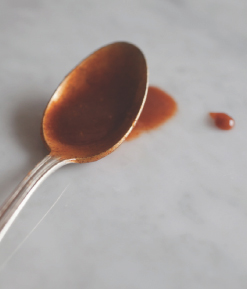
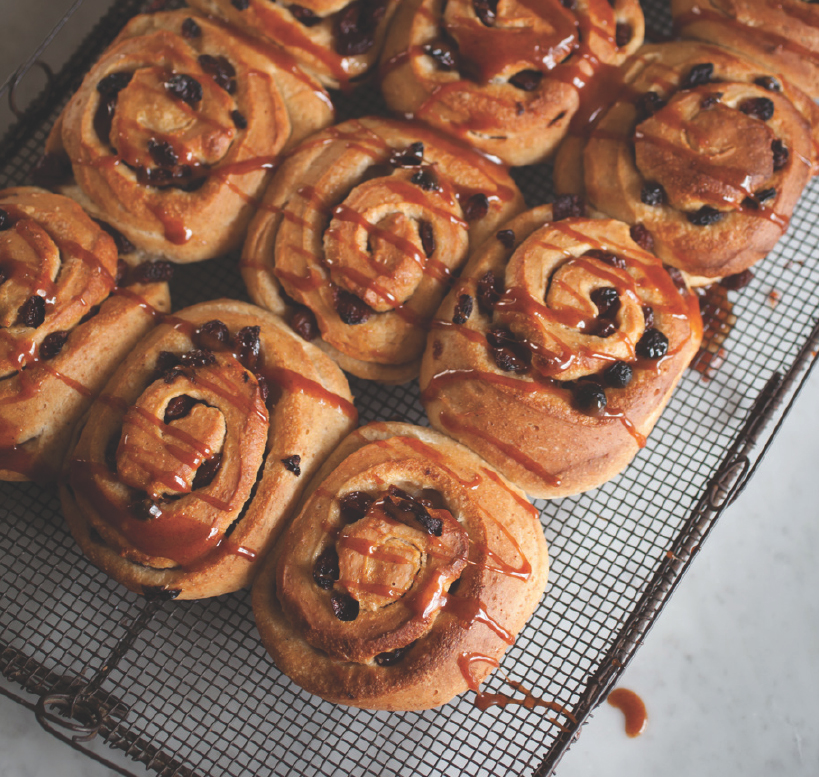
Jennine Walker and Claudia Ehmke have been baking together in their home in Hackney, London, for the past three years, making it up as they go along, with a bit of help from a course at the E5 Bakehouse and a lot of inspiration from travelling and foraging. They love taking their loaves out for a walk and picnic in the countryside, as well as sharing them with friends and family.

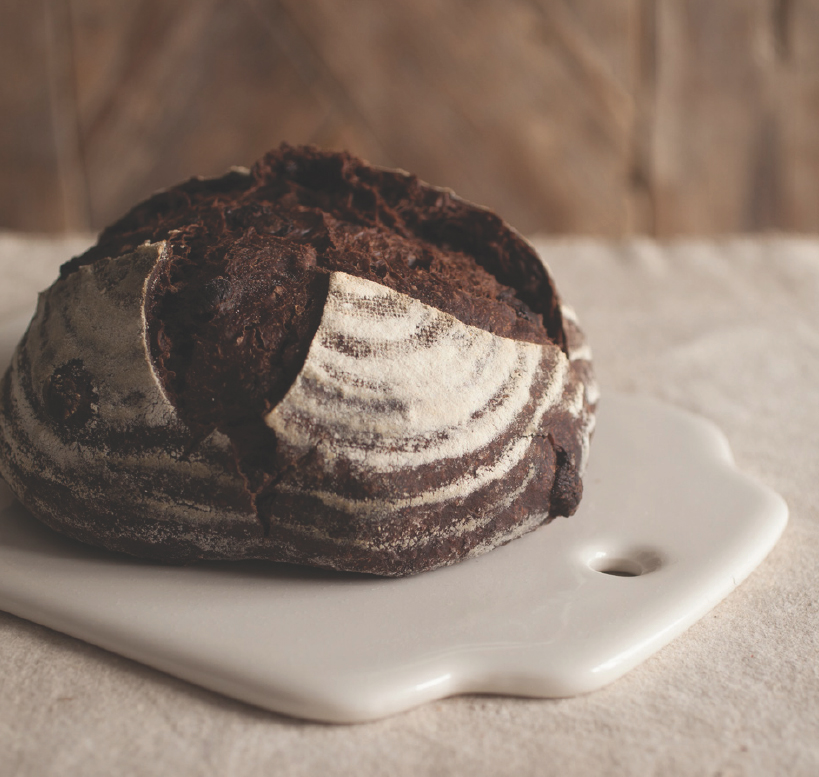
Double Chocolate Sourdough JENNINE WALKER
Jennine told me that this recipe was inspired by a chocolate baguette she found in a Boulogne-sur-Mer bakery one rainy spring day on a weekend trip to France. After several attempts to recreate this at home, she came up with this recipe, which she says is pretty close to how she remembers the flavour, if not the texture.
MAKES: 1 large loaf
FROM MIXING TO OVEN: overnight plus 3-4 hours
BAKING TIME: 35-45 minutes
300g/10½oz/1¼ cups white sourdough starter
200g/7oz/1½ cups minus 1 tbsp white bread flour
160g/5¾oz/⅔ cup water
40g/1½oz/scant ½ cup cocoa powder
15g/1 tbsp honey
6g/1 tsp fine/table salt
100g/3½oz/about ⅔ cup dark/ bittersweet chocolate chips
1. Mix the sourdough starter, flour and water together thoroughly, cover and leave at room temperature for 12 hours (typically overnight).
2. Add the cocoa powder, honey and salt and mix well. Cover and leave to rest for 10 minutes.
3. Knead the dough for around 10-15 seconds, cover and leave to rest for 10-15 minutes. Repeat this knead/rest process until you have a smooth, stretchy, silky dough.
4. Add the chocolate chips and work the dough until they are evenly distributed. Cover and leave the dough to prove for 1 hour, giving it a fold after 30 minutes.
5. Dust a proving basket well with flour. Shape the dough to fit, and put it in the basket, seam-side up. Cover and leave to prove at room temperature for 1-2 hours until doubled in size and the dough doesn’t spring back when pressed gently.
6. Heat the oven to 250°C/230°C fan/480°F/gas 9+, or as high as it will go, with a baking stone or baking sheet in place. Tip the dough out onto a well-floured peel, slash the top and slide it onto the baking stone. Turn the oven down immediately to 200°C/180°C fan/400°F/gas 6 and bake for 35-45 minutes, turning the loaf round in the oven after 15 minutes to ensure even baking, and cover the top with a sheet of kitchen foil if it is browning too quickly.
